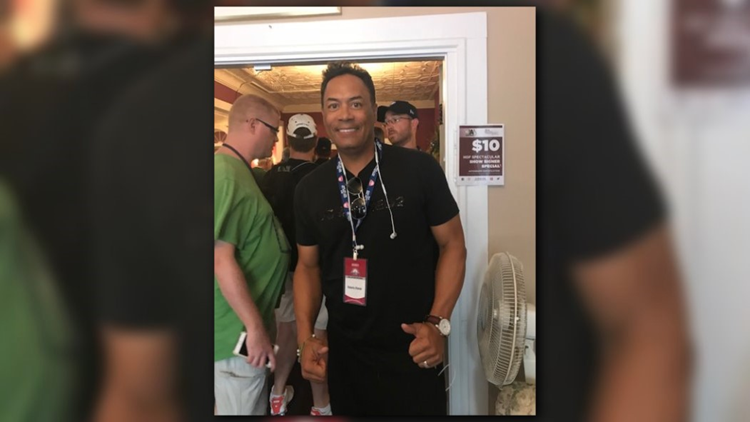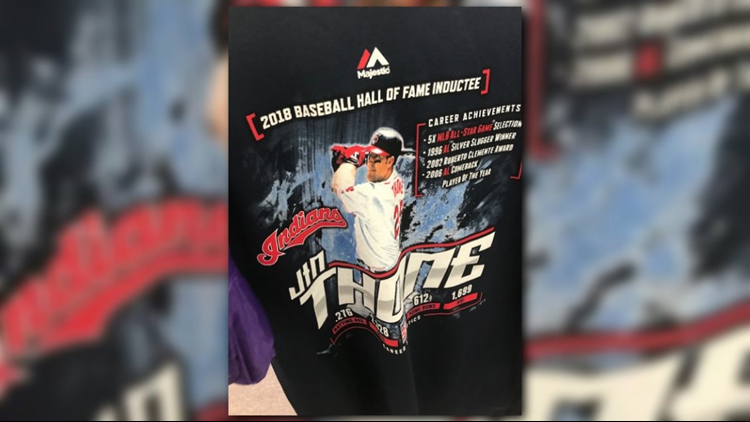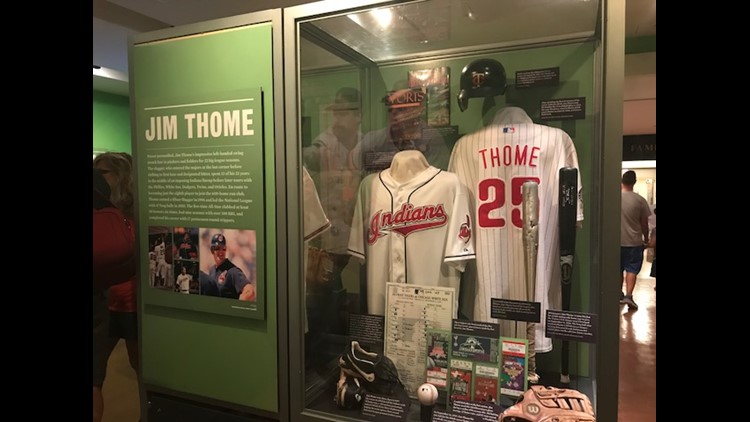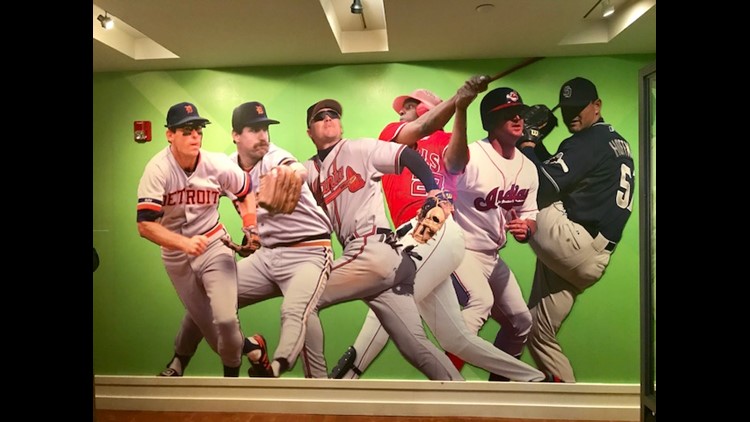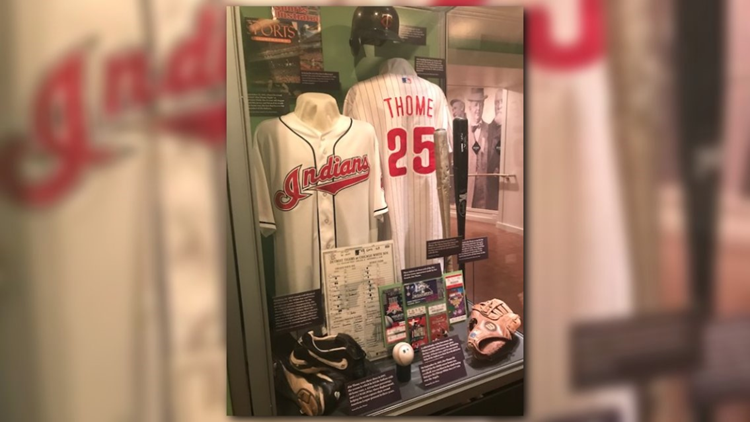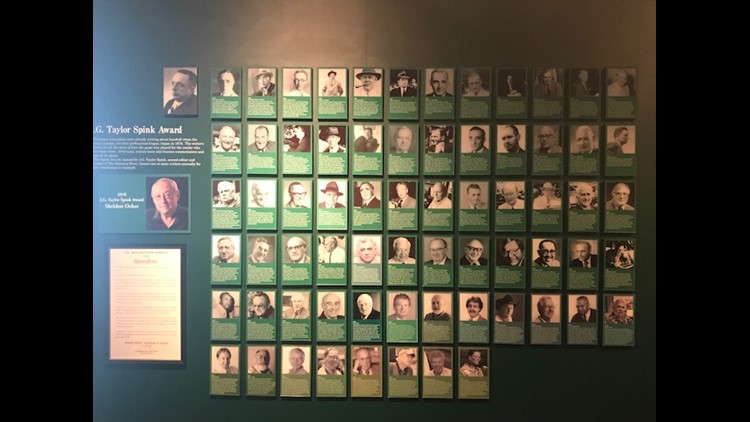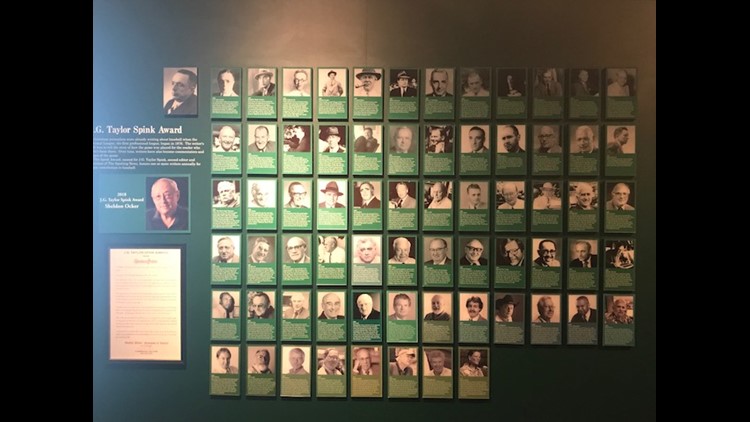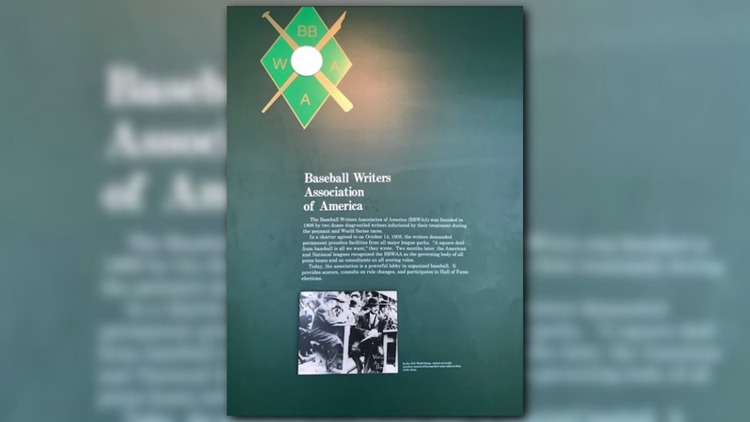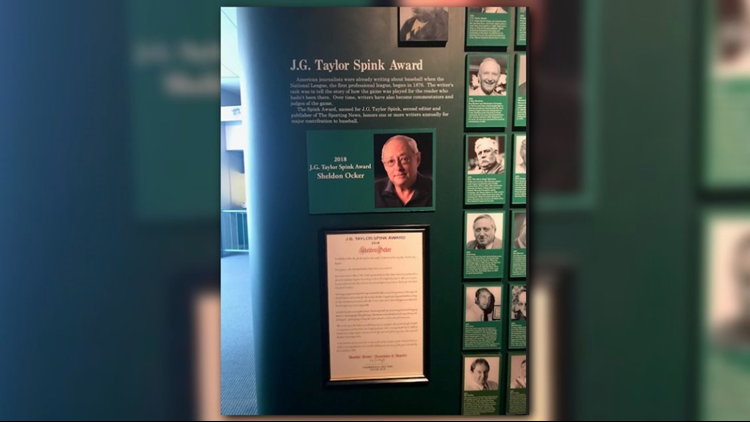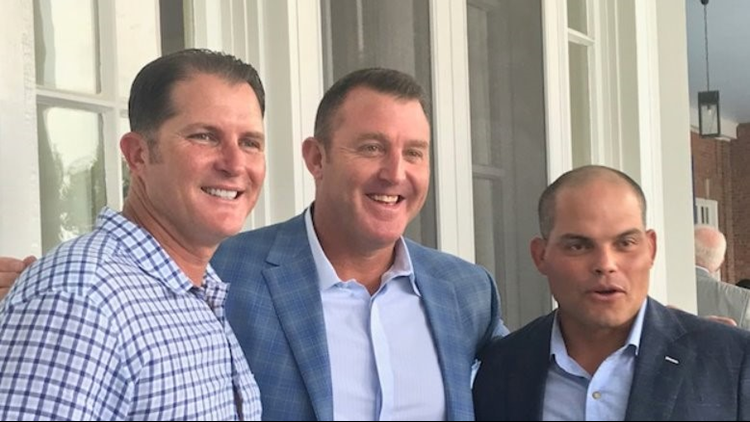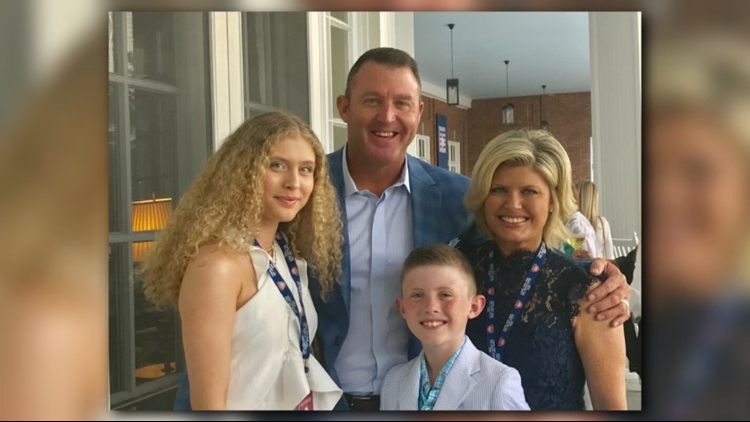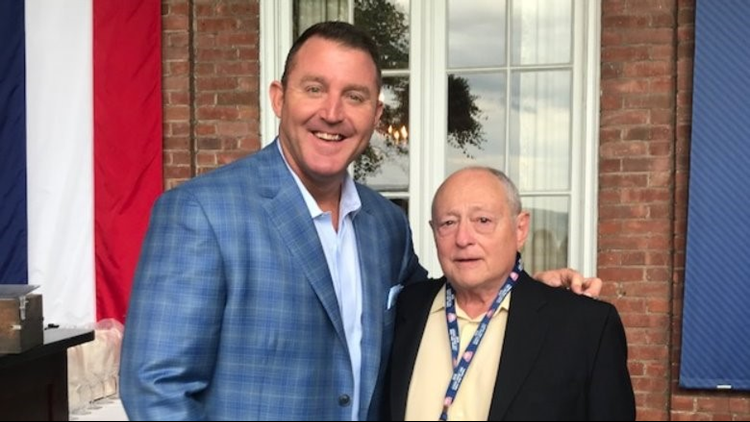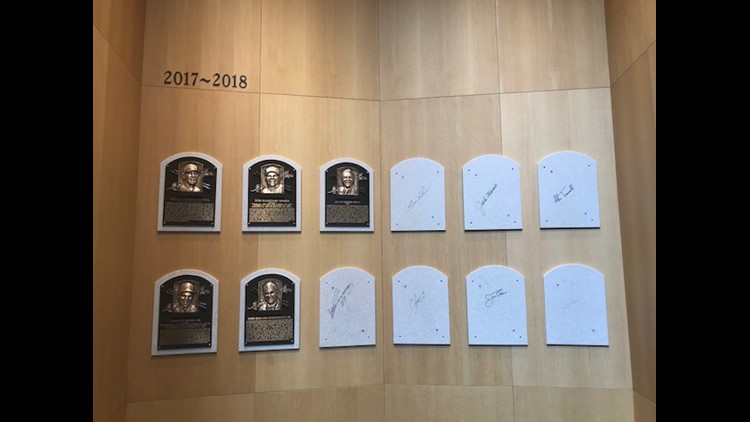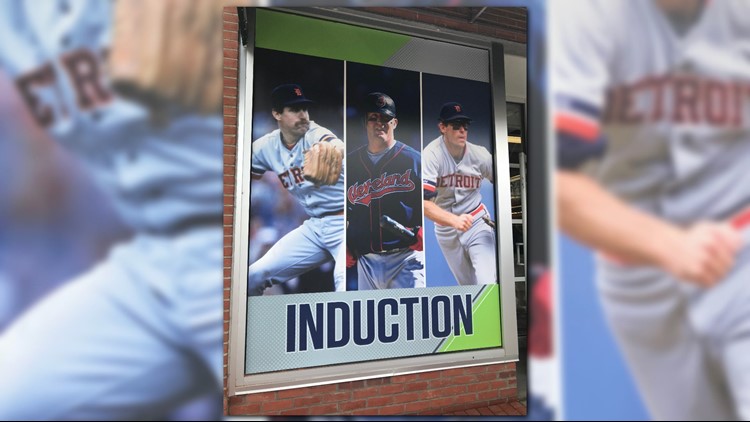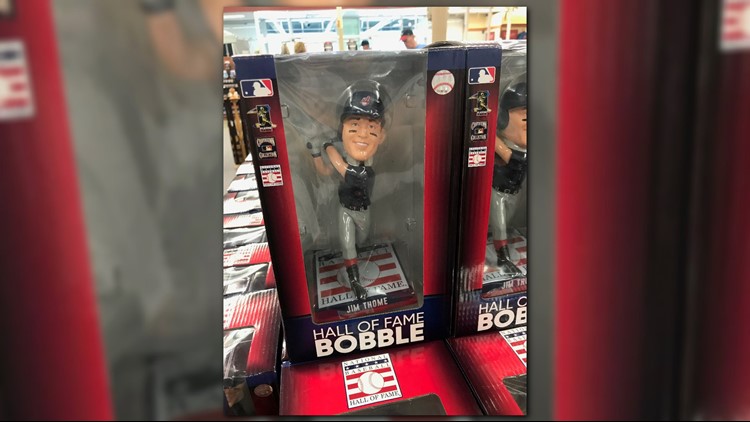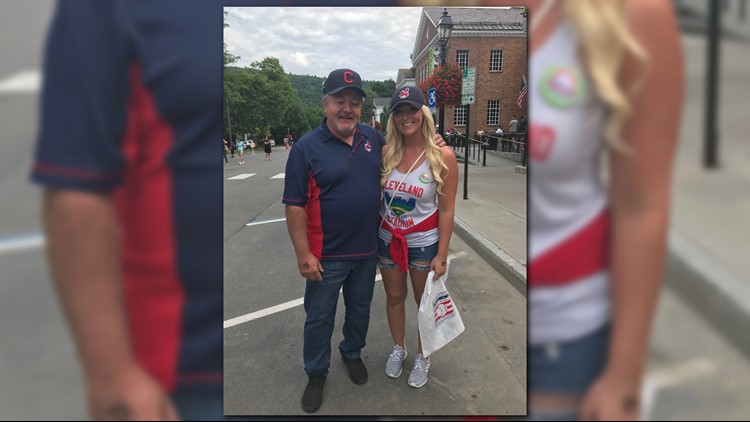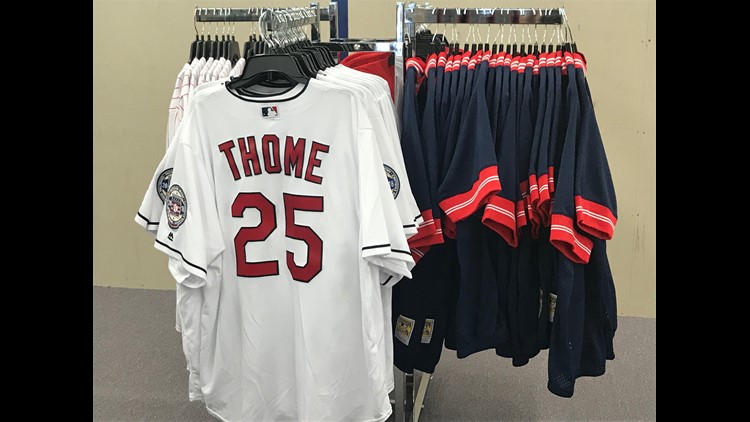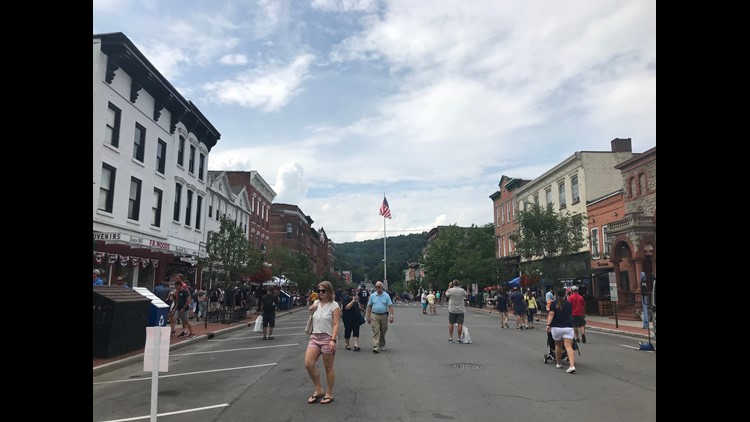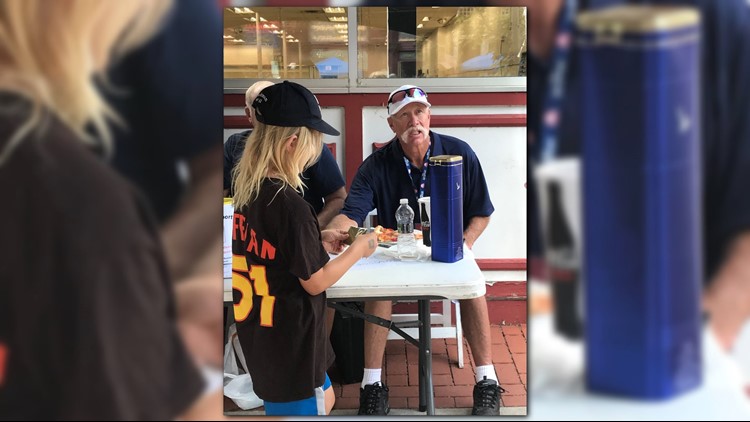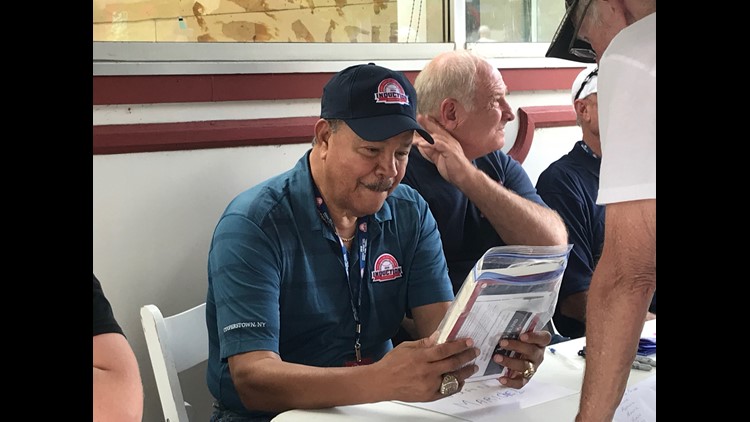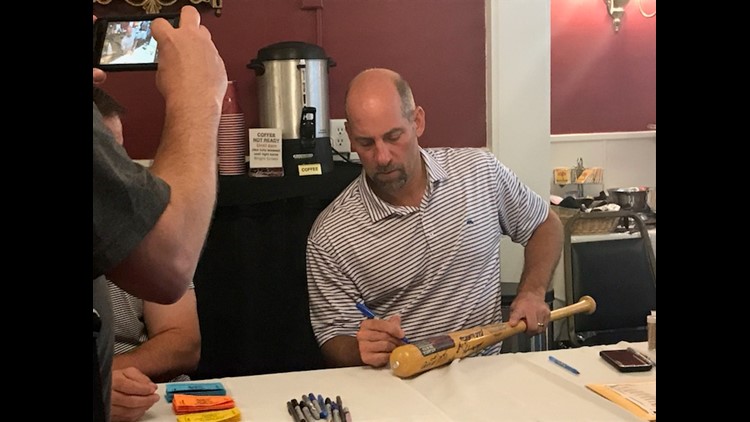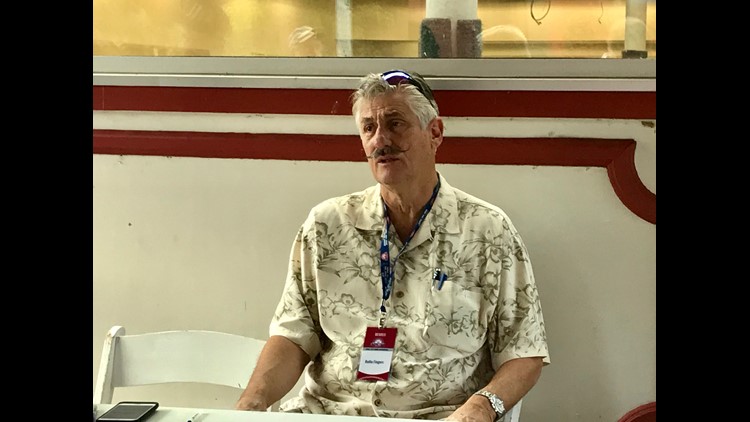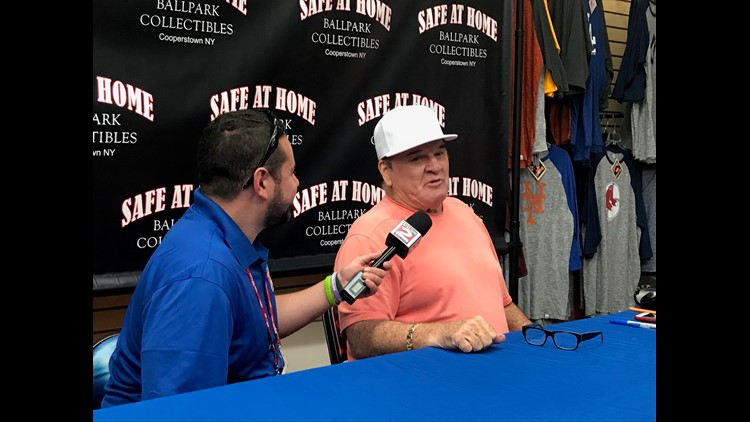TIMELINE | Cleveland Indians legend Jim Thome's Hall of Fame career
Join us as we look back, year-by-year, at just how Jim Thome went from unheralded prospect to baseball legend.
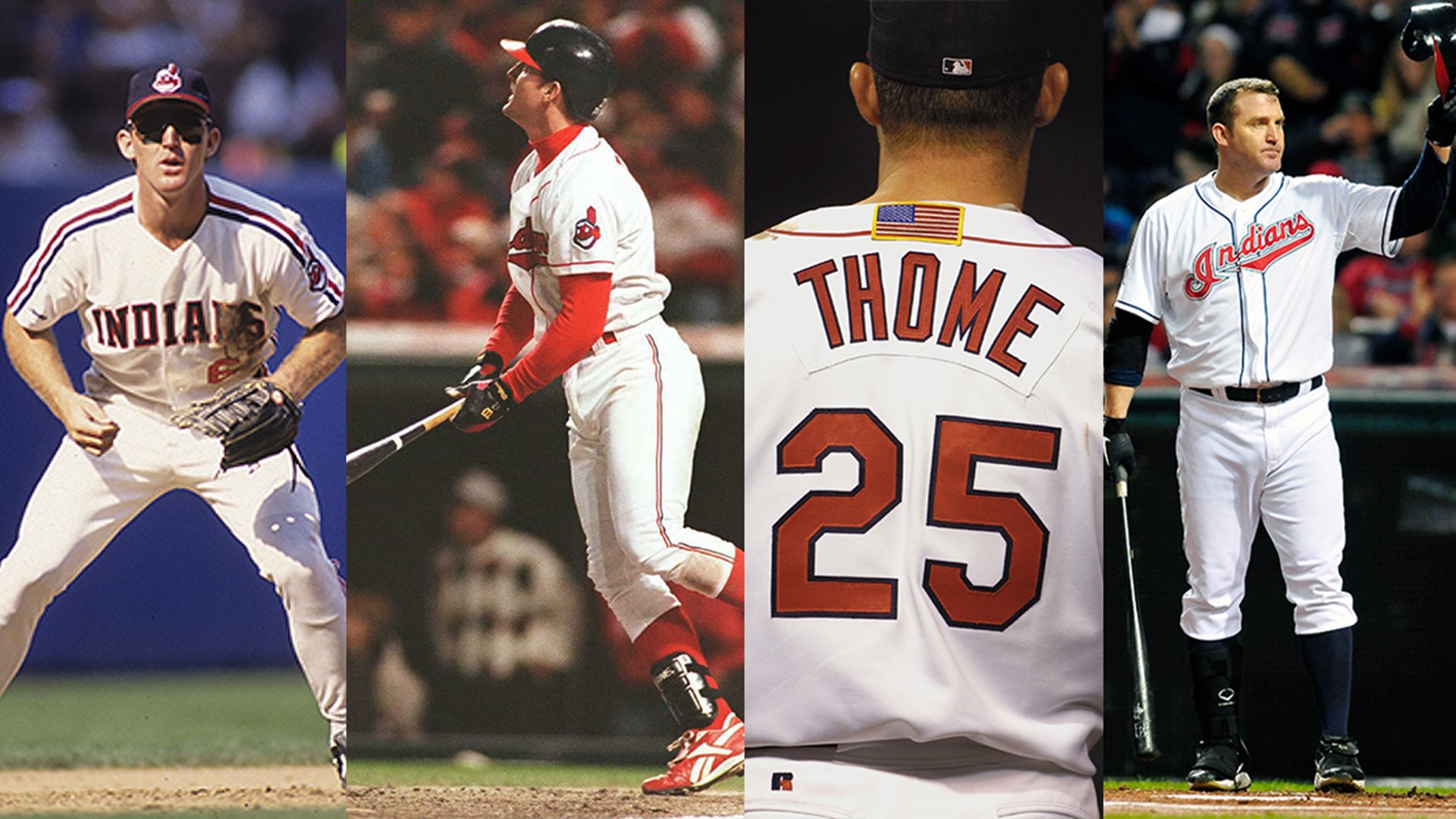
This coming Sunday in Cooperstown, New York, former Indians first baseman Jim Thome will take his rightful place among the giants of the game with his induction into the National Baseball Hall of Fame.
On numbers alone, the honor is well-deserved: 612 home runs, .956 OPS, five All-Star Games. But it was always about more than just numbers with Thome, with teammates, analysts, and fans alike all consistently naming him as one of the nicest people in the sport.
The bulk of Thome's career came right in Cleveland, where he played a defining role on the Tribe's beloved teams of the late 1990s. His plaque in Cooperstown will reflect that, with a Cleveland "C" appearing on his cap.
Join us as we look back, year-by-year, at just how Thome went from unheralded prospect to baseball legend.
1989
Late draft 'afterthought,' minor league beginnings
A native of Peoria, Illinois, Thome was all-state in both basketball and baseball (as a shortstop) but went undrafted, somewhat due to being underweight at 175 pounds. He ended up at Illinois Central College, where after what he called a bad game during his first year, he was approached by Indians scout Tom Couston, who told him not to look at him so no one knew they were talking.
The unorthodox tactic paid off, and in June of 1989, the Tribe drafted Thome in the 13th round (331st overall) and signed him for $15,000. He was assigned to the Gulf Coast League, where he hit just .231 without a single home run.
1990
Gaining a mentor
It was during his second year of professional ball that the 19-year-old Thome would meet the man he most credits with his success: Charlie Manuel, then a manager in the Indians' minor league system. Manuel helped Thome develop more power by opening up his batting stance, allowing him to launch the ball to right field. He also convinced him to relax himself by pointing his bat out to center field before each pitch, which also created a most recognizable pose.

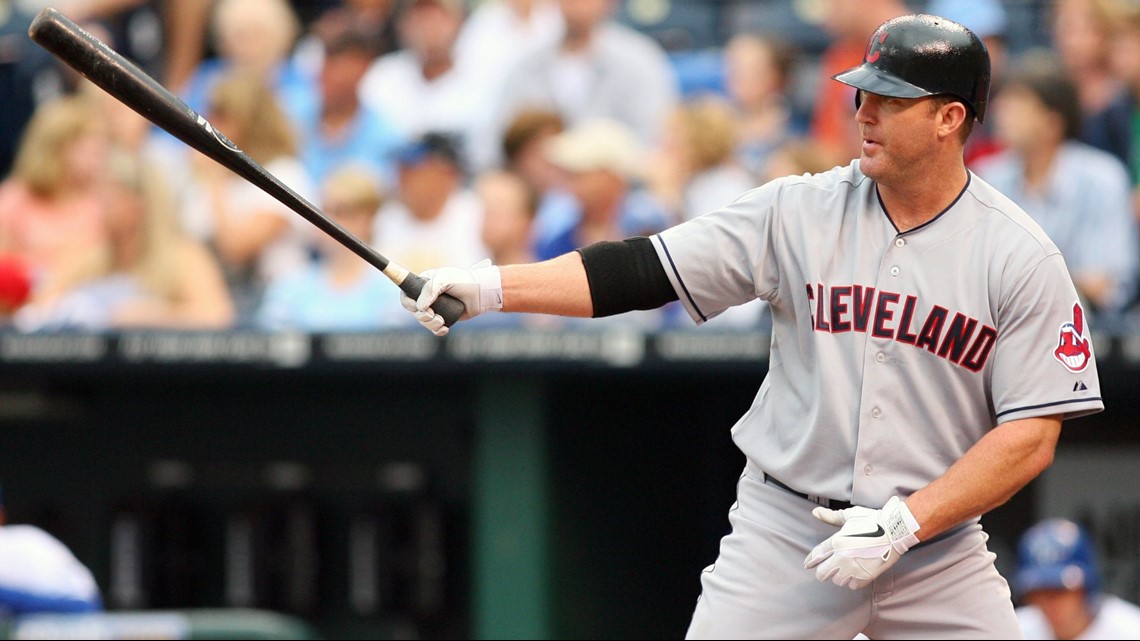
The results were immediate, as Thome combined to hit .340 with 16 homers in both Rookie and Class A ball. His efforts earned him the Lou Boudreau Award as Cleveland's best minor league hitter.
1991
Welcome to the big leagues
Thome had continued success at Double-A and Triple-A by combining to hit .319, although he smashed just seven home runs. He was rewarded with a call-up to Cleveland in September, where the Indians were mired in a miserable last place campaign that would see them lose a franchise-worst 105 games.

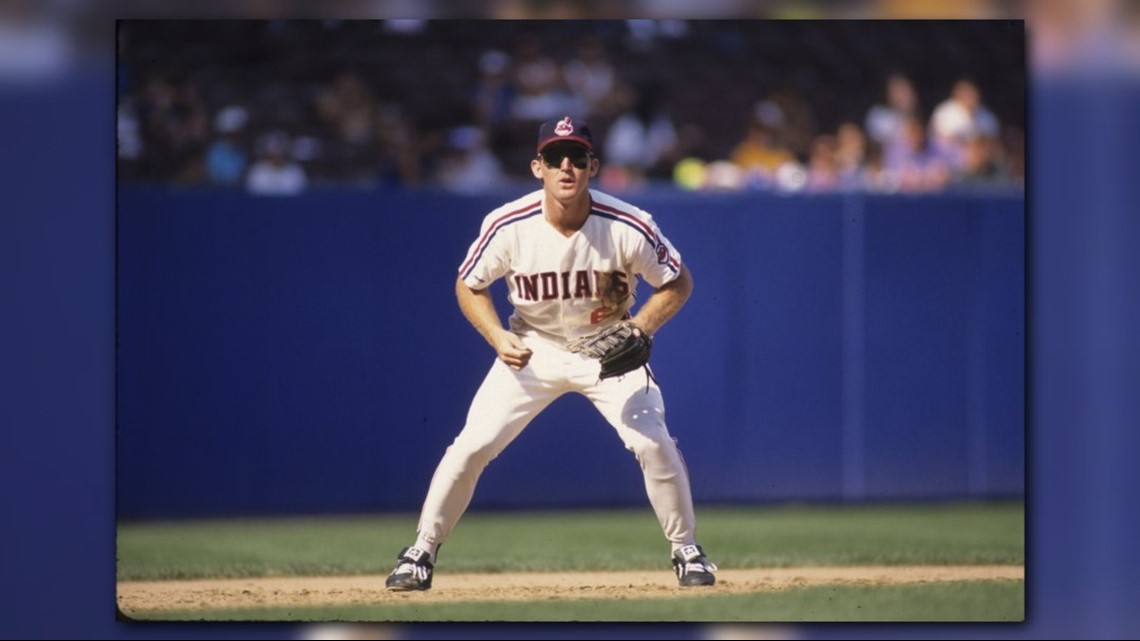
Wearing uniform number 59, Thome made his Major League debut at third base on Sept. 4 in Minnesota, where he singled twice and drove in a run in an 8-4 Tribe victory over the Twins. He would hit .255 with nine RBIs in 98 at bats, and enjoyed his first of many "clutch" moments on Oct. 4 with a two-run, ninth inning, upper deck home run of New York's Steve Farr to give the Tribe a 3-2 win in Yankee Stadium (Thome was then wearing No. 6).
1992
Tough luck with injuries
Thome split time in 1992 between Cleveland and Triple-A Colorado Springs, but was hampered by injuries throughout the year. He hit an eventual career-low .205 with two homers in 40 games for the Tribe, but more notably, would permanently switch to the number 25, which he would wear for the rest of his life.
1993
All coming together
Back in Triple-A and with Manuel again as his manager, Thome opened his stance even more and finally made everything click, slashing .332/.441/.585 with 25 home runs and 102 RBIs for the Charlotte Knights. He once again won the Lou Boudreau Award and earned one more call back to Cleveland on Aug. 13, where he hit a two-run shot his first game in the lineup. Thome would belt seven homers and post an .859 OPS in 47 games for the Indians, who were playing their final season at old Cleveland Municipal Stadium.
1994
The start of something special
As the Tribe moved into the glistening new Jacobs Field, Thome was now in the big leagues to stay, although he struggled early by hitting just .230 with six home runs through the first two months of the season. But thanks, in part. to new hitting coach Manuel, things began to turn around, and on June 15, Thome began to endear himself to the Cleveland faithful with a walk-off, 13th inning home run that beat the Toronto Blue Jays 4-3.
The walk-off was part of a 10-game winning streak, and with a strong core of young talent, a gorgeous ballpark, and a rejuvenated fan base, many had visions of the Indians making their first postseason appearance since 1954. Thome more than contributed, notably with a three-homer performance on July 22 against the first place Chicago White Sox.
Thome would finish his first full Major League season with 20 home runs and an impressive .882 OPS. Unfortunately, the year would end in heartbreaking fashion when MLB players began a strike on Aug. 12. The Tribe was leading the American League wild card race at the time and was just a game out of first, but the postseason and the World Series were canceled.
1995
'Murderers' Row'
Go back into the annals of baseball history, and you'll be hard-pressed to find a lineup better than the 1995 Cleveland Indians. Seven of the nine regulars hit over .300, with the team as a whole batting .291 with 207 homers in a strike-shortened 144-game season. Up-and-coming stars like Thome and Manny Ramirez were often forced to hit near the bottom of the order, a testament to the club's incredible depth.
Thome, for his part, was among the elite, hitting a career-high .314 with 25 home runs and a team-best .438 on-base percentage. The Tribe rolled to 100 wins and clinched the Central on Sept. 8. The final out settled in Thome's glove, as the Cleveland fans celebrated the end of 41 years of frustration and futility.
Cleveland easily swept their first round series with the Boston Red Sox to set up an American League Championship Series showdown with the upstart Seattle Mariners. Both teams split the first four matchups, setting up a pivotal Game 5 at Jacobs Field.
With the Indians trailing 2-1 in the bottom of the sixth, Thome hit what was arguably the biggest home run of his career: a two-run, second deck blast of Chris Bosio that sent the crowd into a frenzy. Thome even punctuated the moment with a vicious bat flip right in front of the Seattle dugout.
Two nights after Thome's heroics, Cleveland won the AL pennant, earning a date with the Atlanta Braves in the World Series. The matchup was a thriller, with every game but one decided by a single run. But the Braves' dominant pitching was just too much, and they won the title in six.
Thome would give fans one more moment to remember, though, with a 475-foot bomb in a Game 5 Tribe victory.
1996
Establishing a presence
According to Baseball Reference, at least, 1996 was Thome's best all-around season: A .311/.450/.612 slash line, five triples, 38 home runs, 116 RBIs, and career-highs in both runs scored (122) and WAR (7.5). His success was partially fueled by manager Mike Hargrove's decision to move him up in the batting order, often hitting third protected by the more boisterous slugger Albert Belle.
The Indians won 99 games and were the favorites to repeat in the American League, but all was not well in the clubhouse: A contract dispute had caused veteran leader and future Hall of Famer Eddie Murray to become disgruntled, and fan-favorite Carlos Baerga was breaking down rapidly. Both were traded in separate July deals, but it wasn't enough to ease the tensions, and the Tribe would end up losing in the AL Division Series to the Baltimore Orioles in a shocking upset. Thome went 3-for-10 in the four-game defeat, but failed to drive in a run.
1997
Socks Up!: Changes, triumph, and heartbreak
With Murray and Baerga already gone, more changes were about to rock Cleveland. First, Albert Belle left as a free agent for the division rival White Sox. Then, just before the start of the regular season, superstar Kenny Lofton was dealt to Atlanta, with management thinking it would not be able to re-sign the impending free agent. Despite getting back fellow All-Stars David Justice and Marquis Grissom in the latter deal, Tribe fans were angry (Mike Hargrove's daughter reportedly would not speak to him for a week after Lofton was dealt) and the club's once-promising future was suddenly in question.
Still, the Indians had championship aspirations, and once overshadowed, Jim Thome was now one of the faces of the franchise. There were changes coming for him, too: Following the acquisition of All-Star third baseman Matt Williams, Thome was moved over from third to first base permanently. He would never be a stellar defender at either position, but he had gradually bulked up from his initial lanky frame and was now 6-foot-4 weighing over 220 pounds. The team felt the switch would help him focus more on pounding the ball.


Playing in a weak division, the Tribe took over first in the Central in June and held onto it the rest of the year, although they were barely above the .500 mark. Through it all, Thome kept on hitting, posting his first ever 40-homer season and leading the AL with 120 walks. He also made his first All-Star team and even participated in the Home Run Derby at Jacobs Field (although he was shut out in the first round).
But it was Thome's wardrobe that perhaps played the most significant role in the 1997 season: On Aug. 27 (Jimmy's 27th birthday) he was not in the starting lineup at the Indians prepared to face lefty Allen Watson in Anaheim. His teammates, however, still wanted to celebrate, and decided to pull their uniform socks up the way Thome always did. Cleveland won that night, 10-4, and the socks became a sort of rallying cry on what would become a magical run.

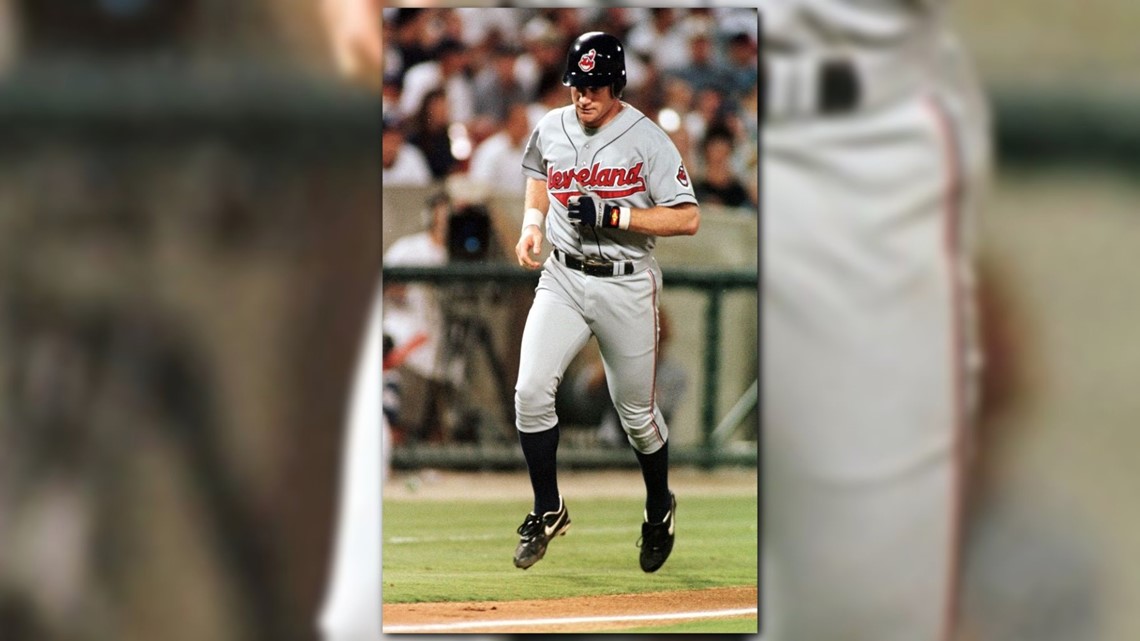
With the socks now rolled up high, the Indians took the division going away despite just 86 victories, then caught fire in the playoffs. Though Thome hit just .138 in the first two rounds, late-game magic and stellar pitching propelled the Tribe past the New York Yankees and Baltimore Orioles for its second American League crown in three years.

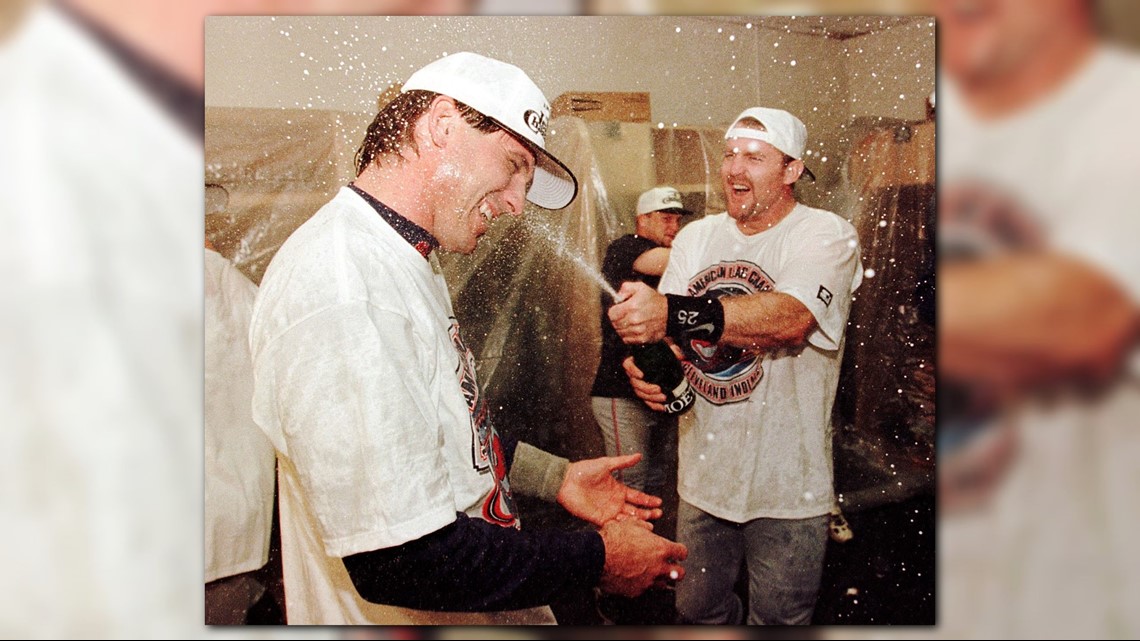
The World Series against the Florida Marlins would turn out to be a classic, and Thome's bat finally woke up with a .286 average and two home runs.
Thome would score the first run of the decisive Game 7 in Miami on a Tony Fernandez single, and the Indians took a 2-1 lead into the bottom of the ninth. Fans know the rest: Jose Mesa's "blank stare", liner off Nagy's glove, and just like that, the Marlins were the champions of the baseball world. It would be 19 years before the Tribe would get back to a World Series, and unfortunately for Thome, he would never get another chance.
1998
Playoff power spoiled by dynasty
Motivated by their crushing World Series defeat, the Indians were once again positioned as contenders, and even brought back Kenny Lofton on a four-year deal. Thome was as good as ever, and was voted to the All-Star Game for the first time as a starter. He was back at the Home Run Derby, too, redeeming himself with a runner-up finish to Ken Griffey Jr.

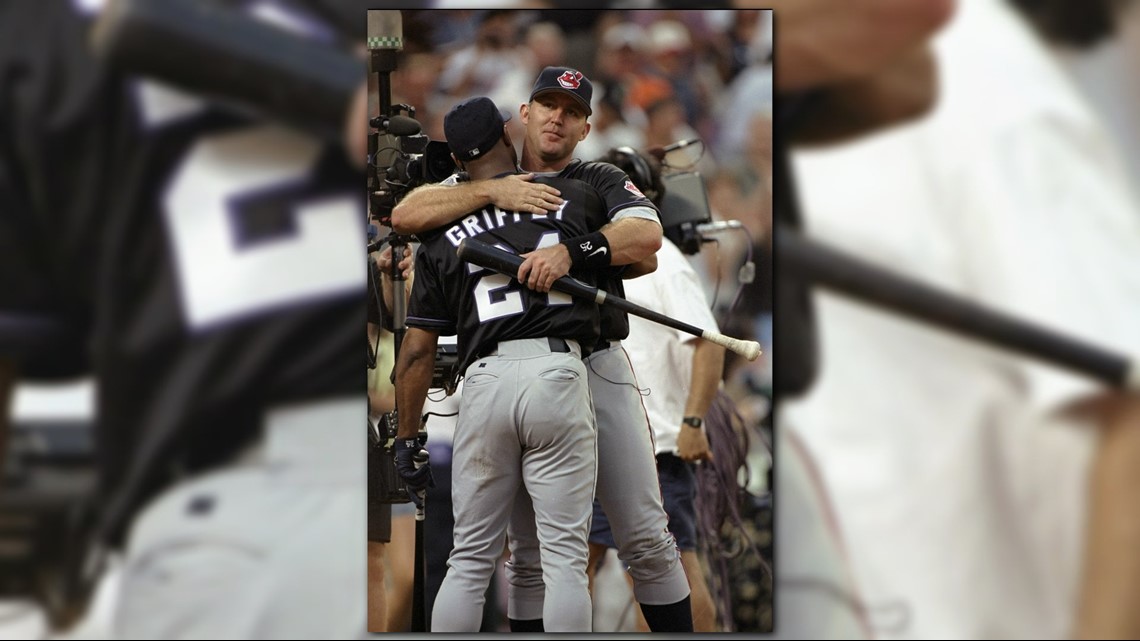
Thome was hitting over .300 with 29 home runs on Aug. 7, when a pitch from Tampa Bay Devil Rays lefty Wilson Alvarez hit him on the right hand, breaking a bone and sending him to the disabled list. The Tribe struggled in Thome's absence, and while he returned with a solo homer on Sept. 16, he would hit just .195 the rest of the regular season. But things were only getting started.
After repeating as AL Central champs and dispatching the Boston Red Sox in the ALDS, Cleveland faced the 114-win New York Yankees for the American League pennant. Surprisingly to most, Cleveland jumped out to a 2-1 series lead, thanks in large part to Thome's two dingers of Andy Pettitte in Game 3.
New York won the next two and headed back to the Bronx up 3-2. After the Bombers jumped out to a 6-0 lead in Game 6, Thome faced David Cone with the bases loaded in the fifth and proceeded to launch the first pitch into the upper deck, cutting the deficit to one and leaving the Yankee Stadium crowd stunned silent.
Thome hit .304 with four home runs in the series, but in the end, the Yanks were a machine. They won the game (and the pennant) 9-5, on their way to their first of three straight world championships.
The year would end on a high note for Thome when in November, he married Andrea Pacione, a North Royalton native and former WKYC anchor.
1999
The one that got away
Following the addition of future Hall of Fame second baseman Roberto Alomar, Thome would help an offense that many feel rivaled the '95 bunch when it came to depth and power. The Indians led all of MLB with a .289 combined average and clubbed 209 home runs, including a then-franchise record 12 grand slams. Manny Ramirez also drove in 165 runs, the most for any player since Jimmy Foxx in 1938.
Thome put together another ho-hum productive season: He once again started in the All-Star game and led the American League in walks while belting 33 more home runs, the most memorable of which traveled 511 feet and bounced out of Jacobs Field during a July 3 win over the Kansas City Royals.
The Tribe rolled to 97 wins and another Central crown before once again meeting the wild card Red Sox in the ALDS, where they stormed out to a 2-0 series lead. Picking up where he left off against the Yankees the year before, Thome hit two homers during those first victories in Cleveland, including a grand slam off John Wasdin in Game 2.
Once the series went to Boston, however, the wheels began to fall off, especially after Game 3 starter Dave Burba was forced to leave after four innings with an injury. Jaret Wright relieved him, and with the game tied at three in the seventh was left in by manager Mike Hargrove, only for he and the rest of the bullpen to give up six more runs in a 9-3 loss. The decision to go with Wright led to the even more controversial move to start ace Bartolo Colon on three days rest the next day. Colon was rocked, and the Indians were pounded 23-7 to set up a winner-take-all Game 5 back in Cleveland.

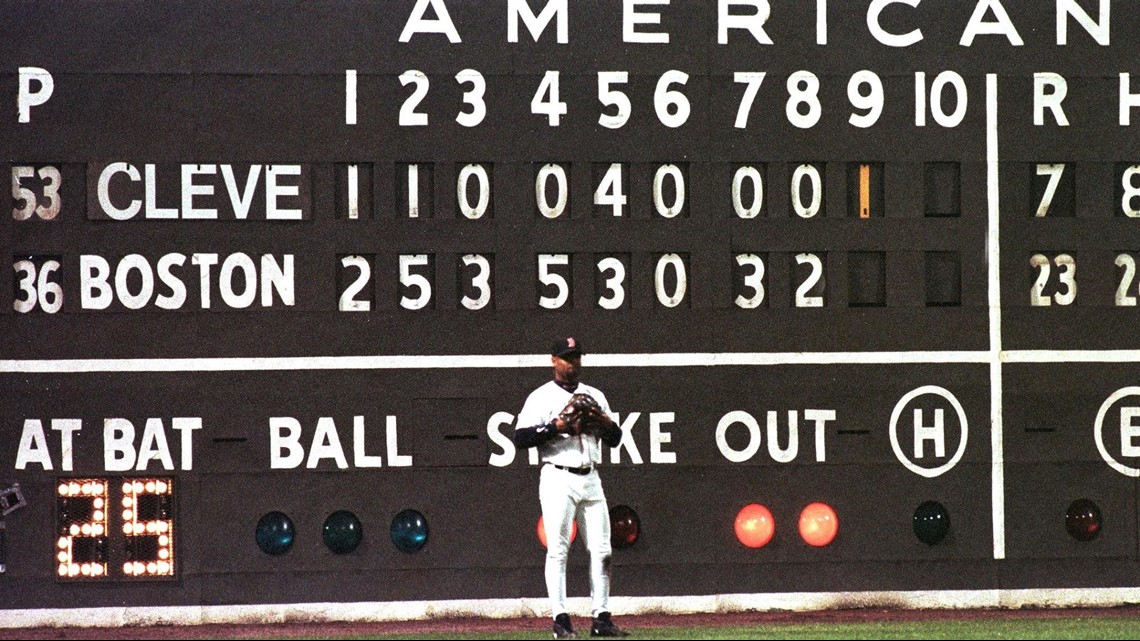
Thome did all he could to propel the Tribe to a victory: Before the third inning was over, he had already hit two tape measure blasts.
But Cleveland starter Charles Nagy couldn't hold the lead, and in the fourth, the game was knotted up at eight when the Sox sent Pedro Martinez to the mound in relief. Martinez would subsequently pitch six no-hit innings, and a three-run homer by Troy O'Leary gave Boston a 12-8 victory.
The collapse proved to be devastating for the Indians franchise, as less than a week afterward, Mike Hargrove was fired after almost nine seasons as manager. It was the first of many signs that the glorious late '90s era of Tribe baseball was coming to an end.
2000
A good, ol'-fashioned pennant race
Owner Richard E. Jacobs, who had helped usher in both a new ballpark and a new winning culture in Cleveland, sold the team in February to Larry Dolan and his family. Longtime hitting coach Charlie Manuel was hired to replace Mike Hargrove. The Indians and their fans still expected to compete for a championship, but it was about to be a lot harder than years past.
Despite posting his lowest marks in batting average (.269) and OPS (.929) in six years, Thome still had 106 RBIs and 37 home runs, including the 200th of his career on Apr. 15.
With the Tribe struggling into June, Dolan and the front office made the difficult decision to start taking the team apart, trading sluggers David Justice and Richie Sexson. The club was also ravaged by injuries (including staff stalwart Charles Nagy), and by Aug. 2 was just a game over .500 and 11.5 games behind the Chicago White Sox, who would break a string of five straight Central division titles won by Cleveland.
Still, the Indians had a shot at the playoffs thanks to the American League wild card spot, and suddenly went on a tear. One moment that signaled the turnaround came from Thome himself: A two-run, walk off homer to beat the Anaheim Angels on Aug. 4.
The Tribe went 38-21 down the stretch, and found themselves in a heated battle with the Seattle Mariners and Oakland Athletics for the wild card. Thome was quintessentially clutch during the final homestand, hitting .357 with four home runs. Cleveland swept the Toronto Blue Jays to end the year, but unfortunately, it wasn't enough, and they missed the postseason by just one game. Many feel that, with the way they were playing, they could have made a deep playoff run.
2001
An all-time great, and a last hurrah
More changes came with the departure of fan-favorites Sandy Alomar Jr. and Manny Ramirez via free agency. Charles Nagy was also on his last legs, going just 5-6 with a 6.40 ERA. The additions of veterans like Juan Gonzalez and Ellis Burks along with young stars like CC Sabathia meant the Indians would still be a contender, but a vastly different one.
A constant, still, was Thome, and the 31-year-old had a stellar year with career highs in home runs (49) and RBIs (124). On May 29, he forever etched his name into Cleveland baseball lore with his 243rd homer, passing Albert Belle for the most in Tribe history.
The Indians were once again in a pennant race, and Thome did his best to make sure they would not miss the playoffs this time around. Of his 49 dingers, three of them were walk-offs.
One of particular significance came on July 7 against the St. Louis Cardinals. Three weeks earlier, Jim's nephew, Brandon, had been paralyzed in a swimming pool accident, and asked his uncle if he could hit a home run for him. Thome would more than oblige, winning the game with a 10th inning shot off Dave Veres.
The Tribe overtook the Minnesota Twins in August and wound up pulling away for their sixth Central crown in seven years. They met the Seattle Mariners (who had tied a Major League record with 116 wins) in the ALDS, falling in five games after the bats went cold late. It would be the last time Cleveland would make the playoffs for six years, and Thome would also hit the last of his 17 postseason home runs during a 17-2 Game 3 rout.
2002
End of an era, but what an ending
Kenny Lofton joined the exodus of Tribe legends by signing with the White Sox, and as spring training began, questions began to arise regarding Jim Thome's impending free agency that was to come after the season. At the time, the Indians were still expected to at least contend, and when asked, Thome made a proclamation he is sure to regret to this day: "They're going to have to tear the jersey off my back." Little did he know what was about to transpire over the next 12 months.

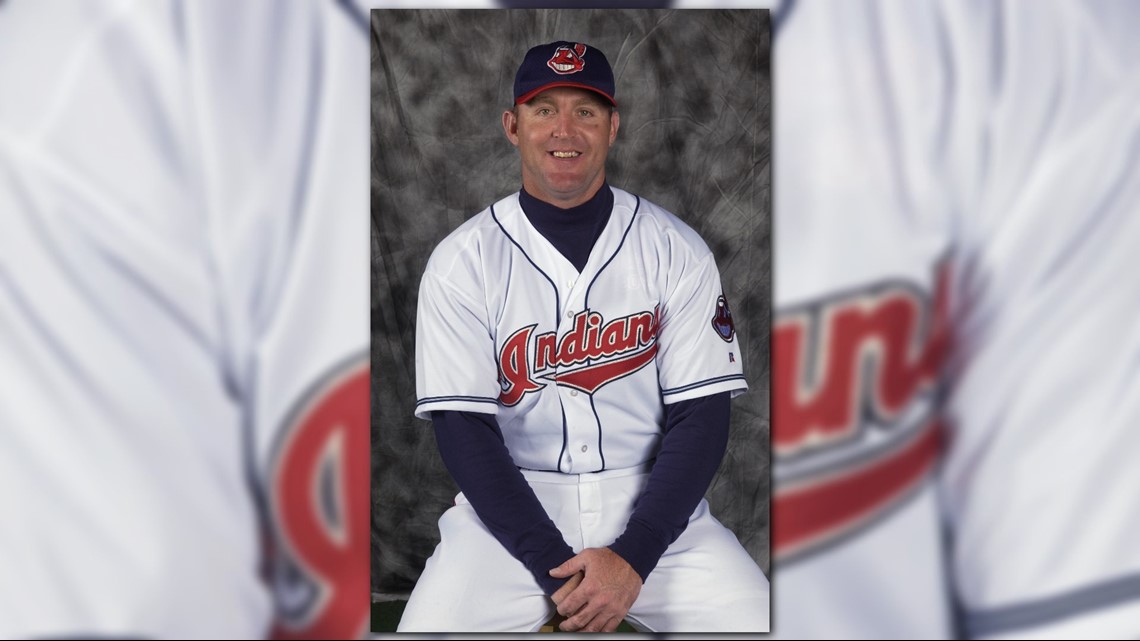
The trouble really began on Dec. 11 of the previous year, when new general manager Mark Shapiro traded All-Star second baseman Roberto Alomar to the New York Mets for a slew of prospects. It would turn out to be the right move, as Alomar broke down quickly upon arrival in the Big Apple, but it was yet another glaring sign the franchise was headed in a different direction. The front office also started to bungle contract negotiations with Thome, first by offering a low-ball four-year, $44 million extension then by inking lesser-known players like Matt Lawton and Ricky Gutierrez to new deals of their own. Several people around the game saw these actions as disrespectful to Cleveland's franchise player, but while it was reported Thome was somewhat "hurt," he never publicly said so.
Dark clouds were looming, but it didn't show initially as the Tribe ripped off 10 straight wins for an 11-1 start. Even after coming back to earth, the club was still in striking distance into June, and Thome was once again a focal point. On June 4, he hit his 300th career home run, becoming the first (and thus far only) player to reach the milestone in a Cleveland uniform.
But on June 27, the bottom fell out, as the Indians shocked baseball by trading ace pitcher Bartolo Colon to the Montreal Expos for, as ESPN initially reported, "Lee Stevens and prospects." Fans were furious, and accused both Shapiro and the Dolans of not doing everything they could to win. It should be noted that two of those "prospects" (Cliff Lee and Grady Sizemore) would go on to become All-Stars in Cleveland, but the Tribe was now in full rebuild mode, punting on contention in the short term to hopefully achieve it in the long term. The '90s were officially over.

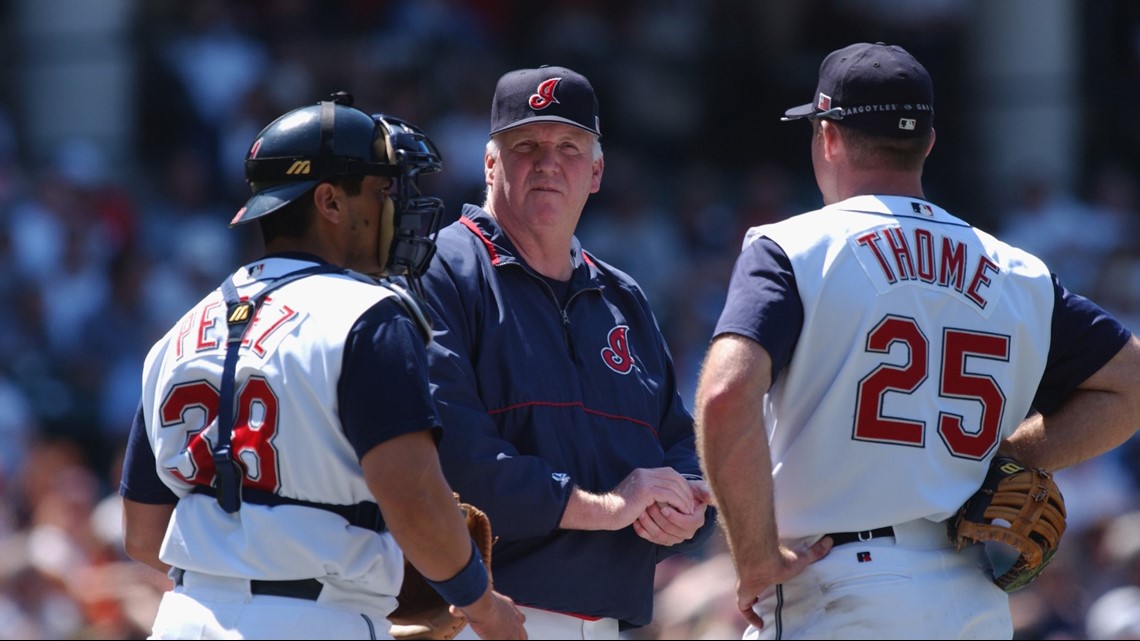
More heartbreaking news was about to take its toll on the team. During the All-Star break, Thome's mentor Charlie Manuel was fired after just two and a half seasons as manager. Only days later, longtime trainer Jimmy Warfield collapsed and died from a brain hemorrhage, bringing immense sadness to an already lackluster season. Thome took the loss of Warfield especially hard, and made it a point to write the initials "JW" in the dirt behind first base before each game.
By this time, Thome had decided to table all contract negotiations until after the season, and nixed the idea of a trade to avoid moving his wife Andrea, who was the pregnant. The Indians would finish third at just 74-88 (their worst record since Thome's debut in 1991), but Thome would put together arguably the best season of his career.
Thome led the American League in walks (122), slugging percentage (.677), OPS (1.122), and OPS+ (197). He also hit .304 and drove in 118 runs, and on Sept. 27, he mashed his 51st homer of the year to pass Albert Belle for the Indians' single-season record.
Just one day later, Thome provided one last bit of magic, tying the game with a three-run, eighth inning home run as an adoring crowd gave him a final standing ovation. His mark of 52 bombs still stands to this day, but it would be the last homer he would hit for Cleveland for nine years.
As free agent talks began to heat up, two teams emerged as the clear front runners: the Indians and the Philadelphia Phillies, with the latter having immediate playoff aspirations. Cleveland upped its offer to five years and $60 million (plus an option for a sixth year), with a promise to re-name the home run porch in left after Thome and also build a statue in his honor.
Thome reportedly agonized over the decision, wanting to stay loyal to the team and town that had given him so much but also thinking about the immediate future. On Dec. 6, it was over: Thome left Cleveland for Philadelphia, signing a six-year, $85 million contract that would eventually increase to $95 million over an extra option year.
At a press conference in Philly to make the move official, Thome was extremely emotional, and talked about how much he "cherished" his time in Northeast Ohio. He claimed he "went back-and-froth" many times and had wanted to retire with the Indians, but also knew that the money he would be receiving might prevent them from making more moves to improve the team. He also praised his wife for her support, calling her his "rock."
Back in Cleveland, the same fan base that cheered and loved Thome for over a decade now turned on him. He was branded a "traitor" after what he had said in spring training, and a "sellout" for taking more money to play elsewhere. In a particularly bizarre line of attack, some even blamed Andrea Thome, claiming she wanted to leave the area and forced her husband out. Jim strenuously denied those rumors, and years later in an interview with Cleveland Magazine, Andrea herself said she never wanting to leave Cleveland, wanting to raise their daughter Lila (who was born later that month) where she herself had grown up. Still, a small but vocal minority of Indians fans still have not forgiven Thome to this day.
In hindsight, most believe Thome was likely forced to take the larger contact by the MLB Players' Association, although he says he has no regrets about his final decision. He was about to begin the next chapter of his career, one he hoped would finally lead to a World Series championship.

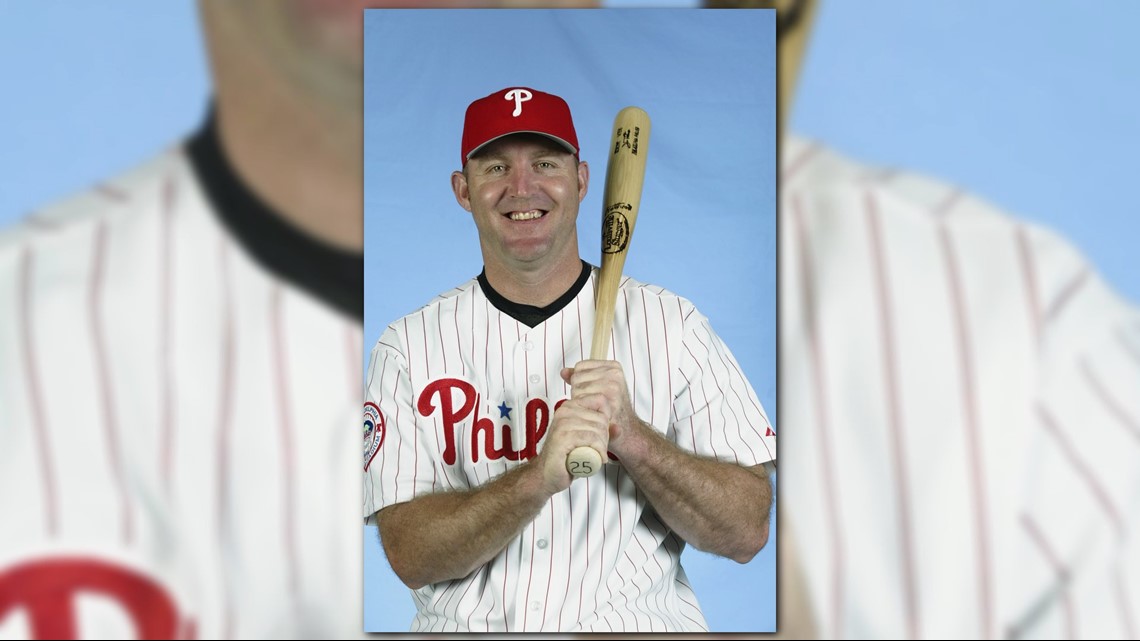
2003
New beginnings
It was certainly strange to seen him in those red pinstripes, but with an up-and-coming lineup that included Jimmy Rollins, Bobby Abreu, and Pat Burrell, Thome arrived in the city with hopes of the playoffs and, down the road, possibly a championship.
Thome made a good early impression with the Philly faithful on Apr. 9 when he belted his first two home runs in a 16-2 win over the Atlanta Braves. But overall, his start was lackluster, and by early May he was hitting just .227 with four homers.
But, as was always typical of Thome, he eventually caught fire, hitting 23 homers over his next 67 games to help the Phillies inch into the race for the National League wild card. A notably memorable showing came on June 21, when he hit two game-tying shots to help the Phils beat the Red Sox 6-5 in 13 innings.
For the year, Thome's average would slump to .266, but he still posted a .958 OPS and tied for the Major League lead with 47 home runs, the only home run crown he would ever win. Unfortunately, Philadelphia lost six of seven down the stretch and missed the postseason.
2004
More milestones, more home runs
For the second time in his career, Thome would be part of the opening of a new ballpark, as the Phillies moved into Citizens Bank Park. This time, he started hot, making his fourth All-Star team and leading all of baseball with 28 homers at the breaks. One of those, on June 14, was the 400th of his career.
The Phils were, at this time, in first place but soon began to crumble, at one point going 1-9 on a single homestand and falling to as many as 13 1/2 games behind. Thome's second half numbers also fell off a bit, although he did finish with 42 homers, the ninth straight season in which he had hit at least 30.
The team would rally to finish the year with 86 wins, but it was not enough to save manager Larry Bowa, who was fired with two games left. To replace him, Philadelphia promoted an old friend of Thome: hitting coach Charlie Manuel.
2005
A low point
On Jan. 5, Jim's mother Joyce—who was always described as his biggest fan—died of lung cancer at the age of 68. She was buried in the family's hometown of Peoria, Illinois, and on the back of her gravestone remains an engraved image of Jacobs Field in Cleveland, with two angels watching over.
Thome was, understandably, devastated, and dedicated the upcoming 2005 season to his mom. Unfortunately, for reasons out of his control, it would be one of the worst seasons of his career.

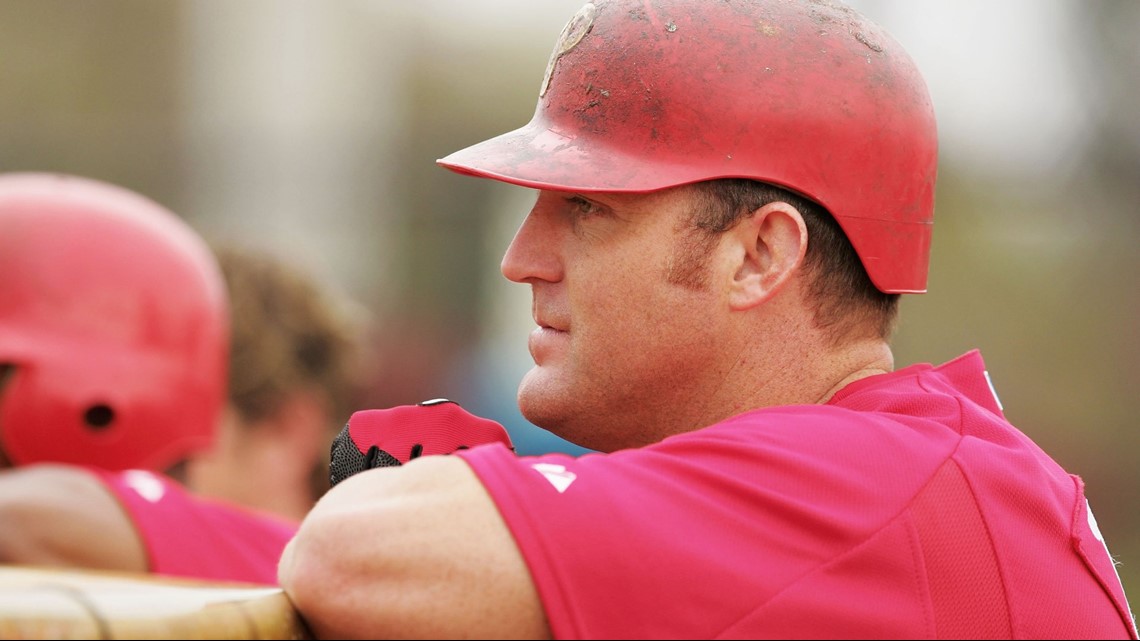
Both the Phillies and Thome got off to a terrible start in April, with the team just 10-14 and the slugger hitting just .203 with one home run. Thome was not completely healthy, and would up missing the first three weeks of May with a lower back strain. He returned to hit six home runs over his next 35 games, but still hovered around the Mendoza line, and on July 1 was put back on the disabled list with tendonitis in his right elbow. While no one knew it at the time, it would end Thome's season, and he finished with a .207 average and a slugging percentage of just .352 with seven home runs in only 59 games.
To take Thome's spot on the roster, Philadelphia called up highly-touted prospect Ryan Howard from Triple-A. The 25-year-old shared several similarities with Thome (including his signature bat point to center field), and the young gun quickly showed his own knack for hitting big home runs. He would smack 22 in 88 games to win the NL Rookie of the Year award, all the while helping the Phils make a late playoff push before falling just one game short.

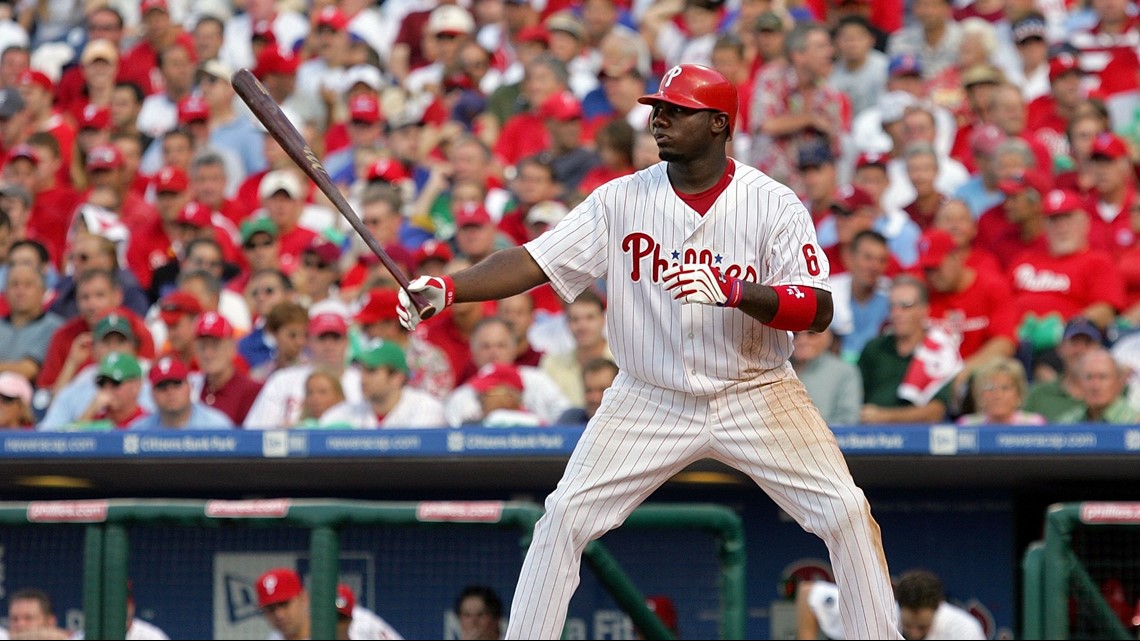
Clearly, Howard was the future, and most fans and experts agreed the 35-year-old Thome could no longer regularly play in the field without a significant injury risk. So, on Nov. 25, Thome was traded to the Chicago White Sox for outfielder Aaron Rowand and two prospects, and the Phillies also agreed to pay more than a third of the roughly $57 million remaining on Thome's contract.
After just three seasons and much fanfare (with no playoff games to show for it), Thome's time in Philadelphia was finished. He would now hope to resurrect his career back in the American League as a full-time designated hitter.

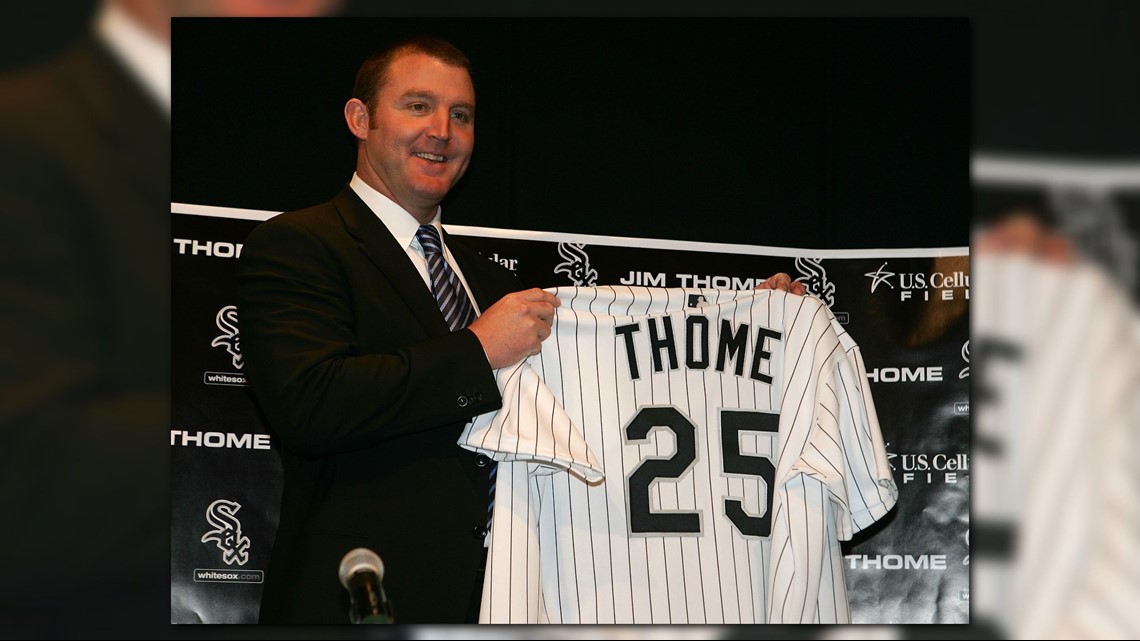
2006
A re-birth
Growing up in Peoria just 150 miles from Chicago, Thome had been a diehard Cubs fan, and while the White Sox have always been known at the city's "other" team, he was overjoyed for the opportunity to play in front of his family and friends from back home. On top of that, the Sox had also just won the 2005 World Series, and most felt Thome could only increase their chances of winning more.
Thome's first game in Chicago came, ironically, against the Indians, the first time he had faced his former team since leaving three years earlier. If there were any doubts about how he would look after his injury-plagued season, he quickly put them to rest with a two-run home run of Fernando Cabrera.
Less than a month later, the Sox came to Cleveland, where Thome stepped into the batter's box at Jacobs Field for the first time in almost four years. While the vitriol wasn't nearly as rancorous as it was for Albert Belle before him or LeBron James after him, Thome was still booed loudly by most of the fans in attendance, and Indians television play-by-play man John Sanders even referred to him as "greedy" on the air. Chicago manager Ozzie Guillen called the episode "embarrassing for baseball," but Thome refused to condemn the fans, even saying years later he "understood" why they booed.
Meanwhile, Thome played all but just a handful of games at DH and put together a first half that had some talking MVP, slashing .298/.414/.651 with 30 home runs and 77 RBIs on his way to a fifth (and final) All-Star Game. The White Sox were, as expected, also in the thick of the playoff hunt.

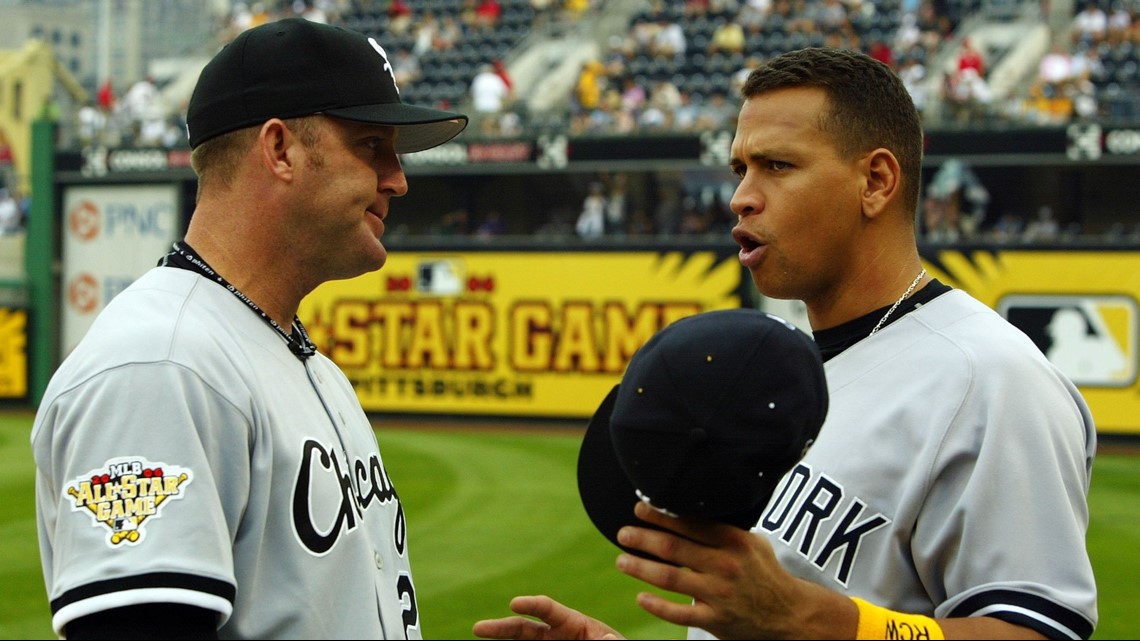
But immediately after the break, Chicago began to struggle, losing 10 of 12 games before finishing the season on a 33-41 skid. They managed to stay in the hunt, but a late push by the Minnesota Twins did them in, and the Sox were finally eliminated on Sept. 25 with a 14-1 loss in Cleveland.
Thome's own numbers would level off slightly, but he finished with a 1.014 OPS and 42 homers, the last time he would ever hit at least 40. For his efforts after struggling with injuries in Philadelphia, he was named the American League's Comeback Player of the Year.
2007
Among the greats
2007 would not be a banner year for the White Sox, as the team that had dominated baseball just two years earlier was out of contention by June and would limp to a 72-90 finish, its worst record in 19 years.
Thome was one of the few bright spots on a mediocre offense, with an OPS of .973 and 35 more home runs. One of those homers, on Sept. 16, would officially put Jim Thome's name among the giants of the game.
With the Sox and Los Angeles Angels of Anaheim tied at seven with a man on in the bottom of the ninth, Thome came to the plate to face right-hander Dustin Mosely. He ran the count full before finally sending the sixth pitch deep over the center field fence to win the game. It was Thome's 500th career home run, making him just the 23rd player in history to accomplish the feat and the only one to do so via a walk-off. Both Thome's wife and father were in the stands for the special moment.
The blast all but assured Thome's spot as a member of the Hall of Fame upon his retirement. Now in the twilight of his career at 37 years old, many around baseball were starting to gain an appreciation for Thome's impact on the game, not just for his incredible numbers, but also for his character and integrity.
After the season, Andrea would give birth to her and Jim's second child, a son named Landon.
2008
'Blackout' magic
2008 may have marked the beginning of Thome's decline. While he still hit 34 home runs, his .245 batting average and .865 OPS were both career-lows for a full season, and for the first time ever he was unable to play even a single inning in the field. But at 38, he still wanted to make the playoffs and compete for a World Series, and he would have to play a major role to make that happen.
The White Sox were contending again, and battled for first place with the Minnesota Twins all season long. Eventually, 162 games would not be enough, and on Sept. 30, the teams would have to meet for a one-game playoff in Chicago to decide who would win the Central division. The Sox asked their fans to wear all black, creating a "blackout" atmosphere throughout U.S. Cellular Field.
Starters John Danks and Nick Blackburn dominated, and the game remained scoreless into the bottom of the seventh. Thome faced Blackburn to lead off that frame, and with the count 2-2, sent a hanging breaking ball 464 feet to dead center to give the Sox a 1-0 lead.
Thome would later call it one of the biggest home runs of his life, and it also cemented his legacy in Chicago (not just Cleveland) baseball lore. Neither team scored again as the White Sox clinched the division 1-0, the first time Thome had been to the playoffs since 2001.


The Sox faced the upstart Tampa Bay Rays in the ALDS, but fell in four games, with Thome held to just two hits and one RBI.
2009
Bouncing around
Thome's decline hastened in 2009 with just 23 homers (he would never hit 30 in a season again) and a 117 OPS+. The White Sox, despite hanging in the pennant race into August, would not repeat as Central champions, and wanted to give the aging slugger a shot at a title. With that in mind, Thome was once again traded on Aug. 31 to the Los Angeles Dodgers.

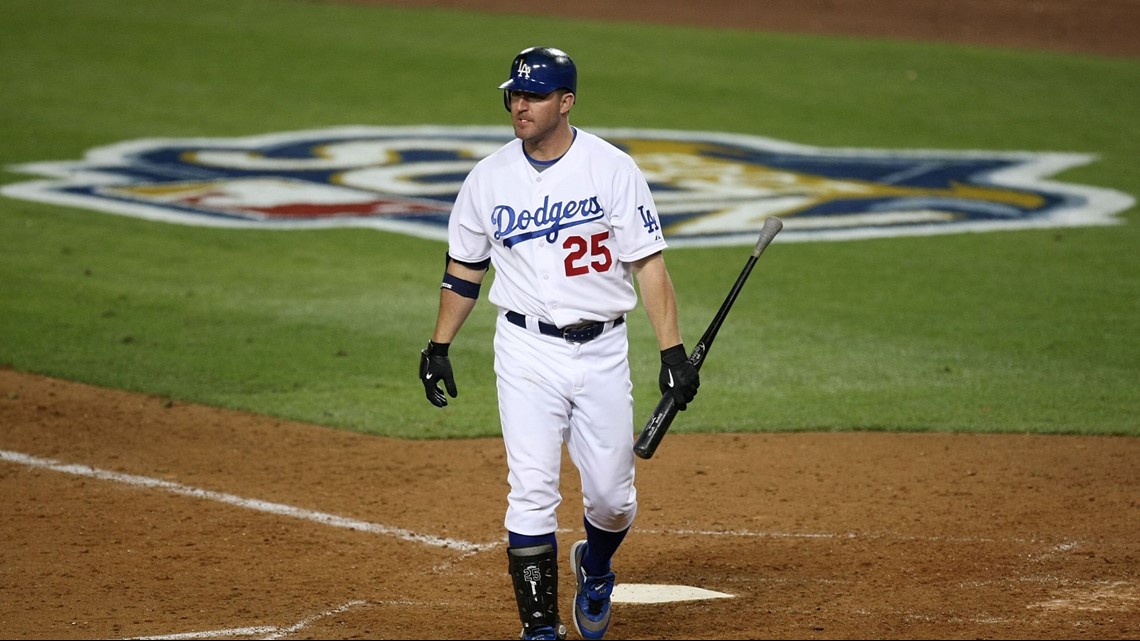
While the fans in Hollywood gave the popular Thome a warm welcome, he was still unable to play first base, which limited him strictly to pinch hitting duties. He registered just four singles and three RBIs in 17 at bats.
The Dodgers finished with the best record in the National League and reached the National League Championship series, but were defeated by the Philadelphia Phillies (Thome's former team) in five games. Thome had only one hit in the postseason.
2010
Elder statesman
About to turn 40 and a free agent once again, Thome decided to return to the AL Central (albeit for a much lower salary) by signing a one-year, $1.5 million contract with the Minnesota Twins. The club, like the Indians and Phillies before it, was about to open a brand new ballpark as a contender, and hoped Thome would be able to provide some pop in the lineup as well as be a leader in the clubhouse.

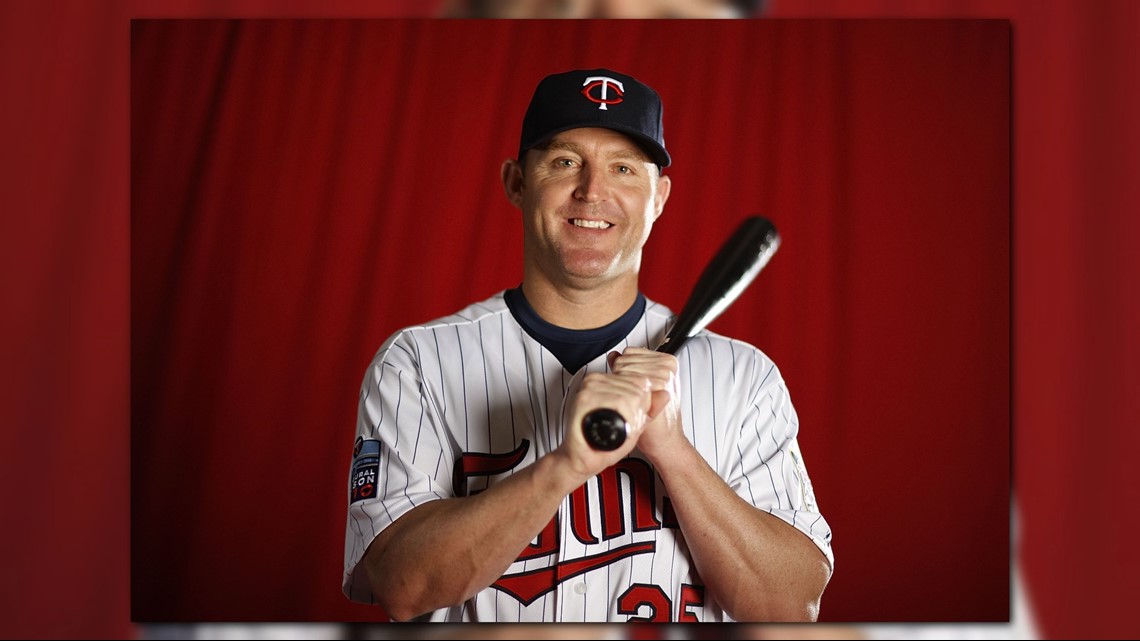
Thome more than exceeded expectations on both fronts, quickly becoming a favorite figure both with his teammates and the Minnesota fans. And though he made just 340 plate appearances, he still posted a mammoth 1.039 OPS (his highest since 2002) and mashed 25 home runs, including a two-run shot on Aug. 17 for the first walk-off hit in Target Field history.
The Twins rolled to their sixth Central crown in nine years, but were overmatched in a three-game ALDS sweep by the defending champion New York Yankees. Thome went just 1-for-10 in the defeat.
2011
Immortality, and coming home
Thome re-signed with Minnesota for $3 million, but the team suddenly collapsed, and found itself in last place thanks in part to injuries to top players. Thome himself made multiple trips to the disabled list, and finished the season with only 15 homers in 93 games. However, it would still be a banner year for the aging veteran, as all of baseball had history on its mind.

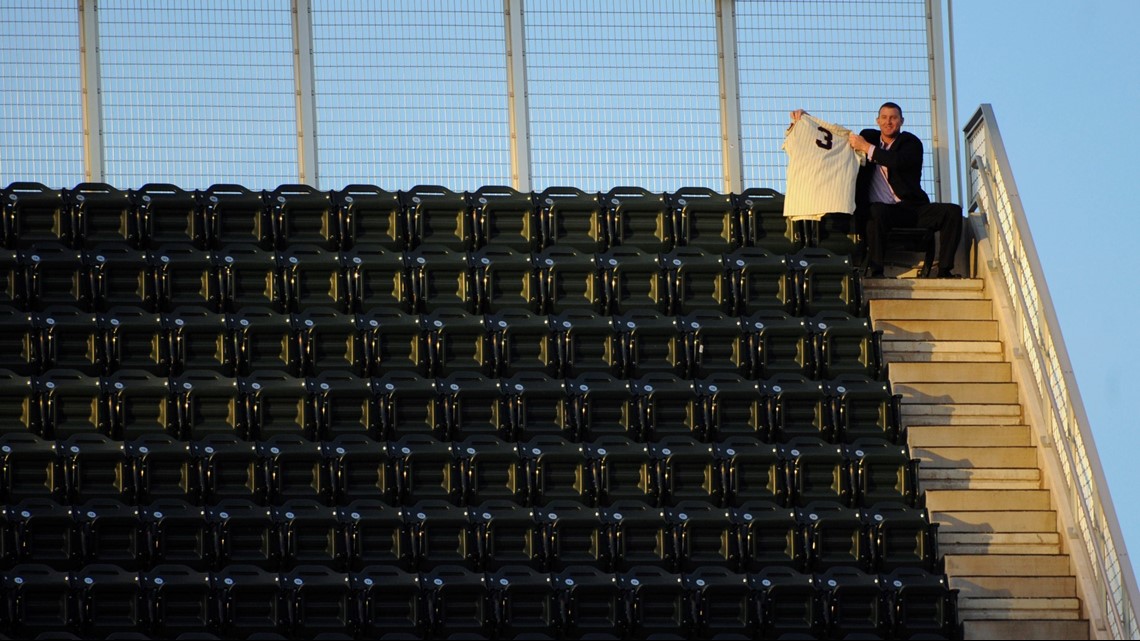
On Aug. 15, the Twins were in Detroit to take on the Tigers, and Thome was sitting on 598 career home runs. After belting No. 599 in the sixth, Thome returned to the plate in the eighth, and hit an opposite field shot to join Barry Bonds, Hank Aaron, Babe Ruth, Alex Rodriguez, Willie Mays, Ken Griffey Jr., and Sammy Sosa (and later Albert Pujols) and the only players in the 600 home run club. As had been the case with 500, Thome's wife and father (along with his children) were there to greet him at home plate.
Fans and analysts around the sporting world lavished praise upon Thome, who had so often been overlooked in favor of other power hitters of his era. Of particular note, Thome had always been seen as a "clean" player, with nary a shred of evidence tying him to performance-enhancing drugs (unlike Bonds, Rodriguez, and more). It was the perfect opportunity to celebrate the contributions of a man who had always played the game "the right way," with class.
But further east, things were about to get even more interesting: The Indians had emerged as surprise contenders in the AL Central, and were looking to add reinforcements to a lineup hit by injuries of its own. Thome's name quickly emerged as a candidate, and rumors began to swirl that maybe, just maybe, he could return to Cleveland.
The Twins placed Thome on waivers roughly a week after his 600th homer, and the Indians put in a claim, although the Phillies—who had a much better shot at winning the World Series—also desired his services. In the end, however, it was the man himself who decided to waive his no-trade clause and send himself home, and on Aug. 25, Jim Thome was officially back with the Cleveland Indians.


Thome was in the lineup the very next night at the now-renamed Progressive Field, and this time, the crowd of more than 41,000 gave the legendary first baseman a standing ovation. Thome returned the gesture, tipping his helmet in respect. After all of the hard feelings that came with his departure, he was a Cleveland hero once again.
Thome went 0-for-4 that first game and started 0-for-1 the next night, Aug. 27. It was his 41st birthday, and the fans were hoping for just a little more magic from their aging star. They got it in the sixth, when down 4-3 facing Danny Duffy, Thome parked a 1-1 pitch into the left field bleachers. It was his 335th home run as an Indian, and the first with the team since September of 2002.
Thome did a fine job in his return, hitting .296 with three homers in 22 games. Unfortunately, the Tribe fell apart shortly after he arrived and finished a distant second place at 80-82. Most realized it would likely be Thome's final season in Cleveland, and the team wanted to honor him properly.
On Sept. 23, the Indians held "Jim Thome Appreciation Night" at Progressive Field. The weather was terrible, but more than 36,000 fans braved the rain to pay their respects to the greatest power hitter in franchise history.

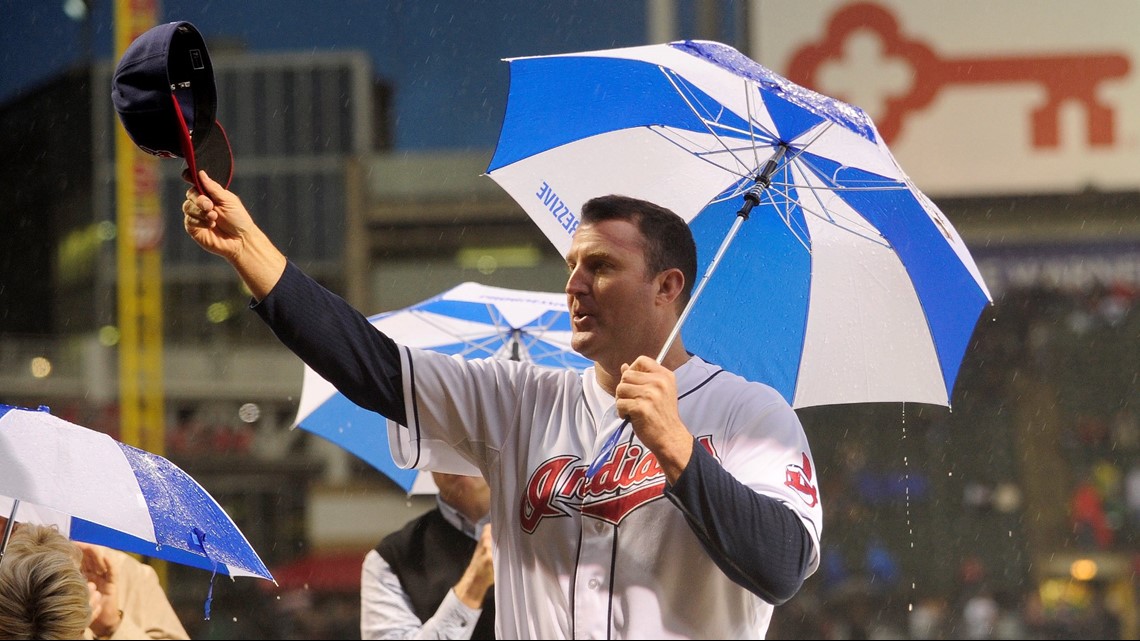
Thome thanked the fans and the club in a speech, and President Mark Shapiro and former manager Mike Hargrove presented him with a special jersey commemorating his days in Cleveland. Additionally, it was revealed that a bronze statue of Thome's likeness would be built upon his retirement.

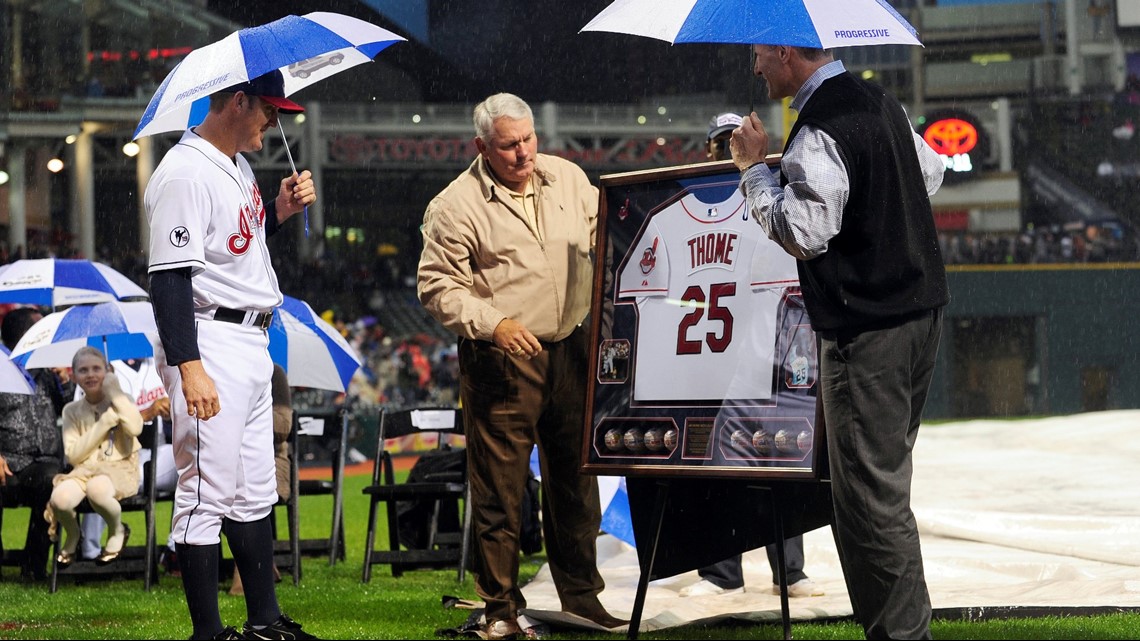
Then, "a Hollywood script": Jimmy came to the plate with the Tribe down 4-2 in the third and a rookie named Jason Kipnis on first. With a 1-1 count, he crushed a Carl Pavano pitch deep over the center field wall for the final home run of his Cleveland career. The crowd erupted one last time as Thome gave a curtain call, and in vintage '90s form, the Tribe went on to win 6-5 in walk-off fashion.
Two days later, Thome was not in the starting lineup for the last home game of the season, but was called in as a pinch hitter in the eighth inning, drawing a walk. In a strange but appropriate tribute, manager Manny Acta then inserted Thome at third base, the position he had played when his career began. Not wanting to risk injury, he was pulled after just one pitch, and said one more goodbye to the Progressive Field faithful.
Thome would play two more games in a Cleveland uniform during the final road trip in Detroit, picking up a double and an RBI on Sept. 27 before striking out the next day in his final at bat. He finished his Indians career with a .287/.414/.566 slash line and 48 WAR, and remains the franchise's all-time leader in home runs (337) and walks (1,008).

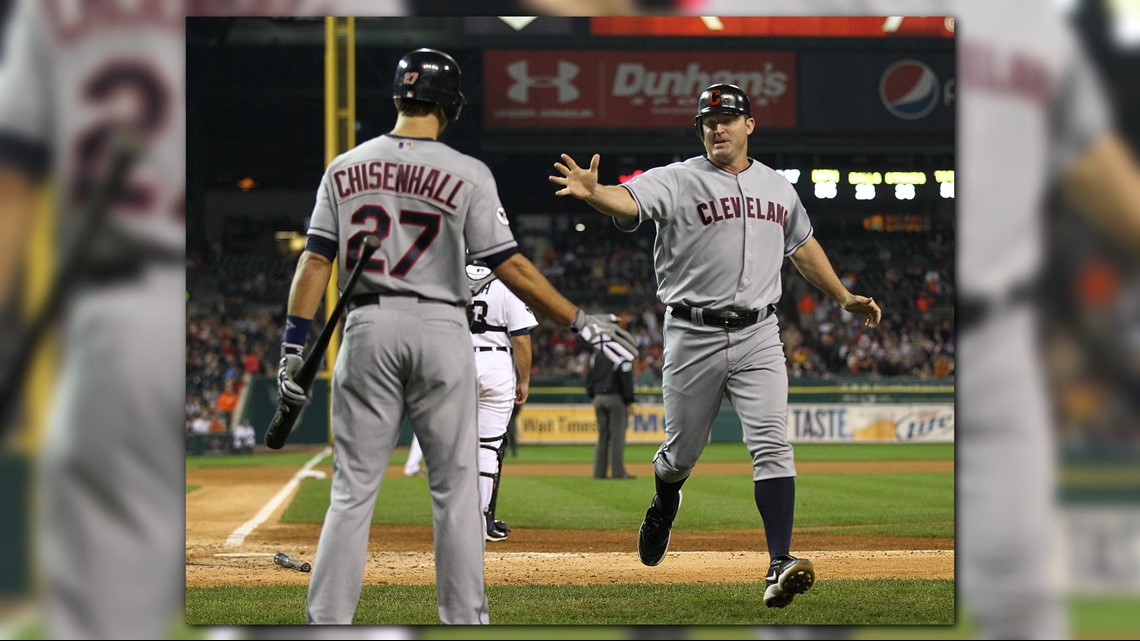
2012
The final days
Thome had gotten his storybook ending in Cleveland, but still felt he had more to give to the game, and signed a one-year, $1.25 million contract to return to the Phillies. Philadelphia had been to the playoffs five years in a row (with two pennants and a World Series title), and Thome saw it as one more chance to get a ring. There was a catch, though: With the Phils in the National League and Ryan Howard (his replacement seven years earlier) hurt, Thome was expected to play first base, something he had not done since 2007.

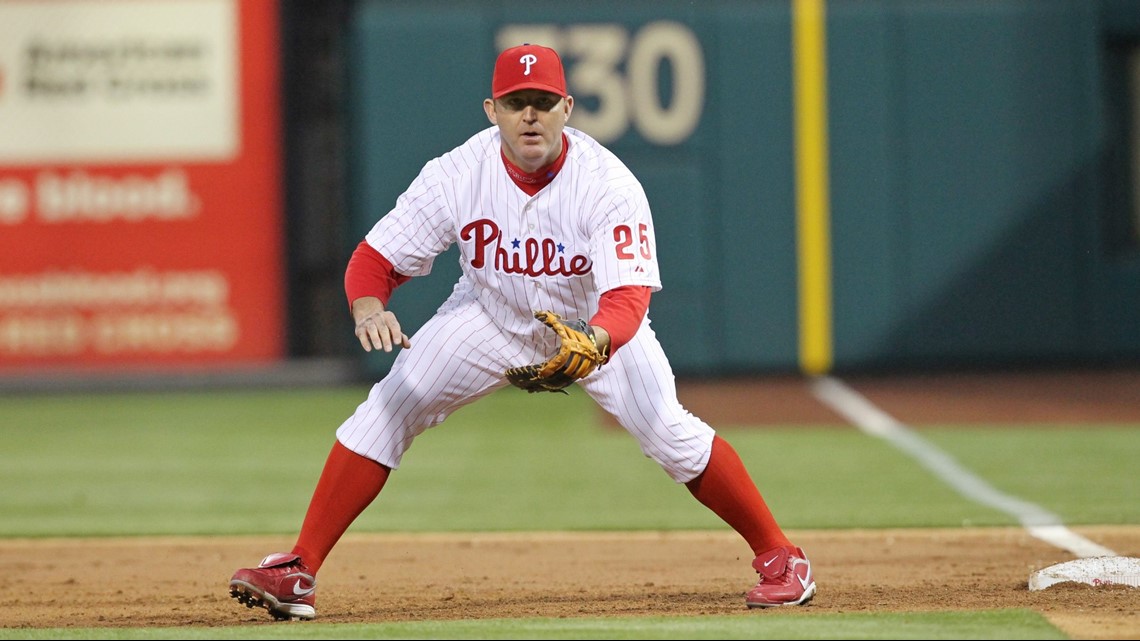
Thome struggled throughout the first month, hitting just .111 with no home runs before being placed on the disabled list with a bad back. However, he quickly managed to turn things around after coming back in June, belting five homers to become the fourth player in baseball history to hit at least 100 with three different teams.
The fifth blast, a walk-off on June 23 against the Tampa Bay Rays, was the 13th walk-off of Thome's career, a Major League record.
As it turned out, it would be his last home run for Philadelphia, as the team was quickly falling out of contention and looking forward to getting Howard back in the lineup. On June 30, Thome was traded to the Baltimore Orioles (his sixth team), where he was set to serve as their full-time DH.
His first home run with the O's came three weeks later at Progressive Field, where much of the Indians rooters cheered him as he rounded the bases.
But only a week later, Thome was back on the DL with a herniated disk, and would miss nearly two months. He still did his best to help the young Baltimore squad (battling for its first playoff spot in 15 years) in the clubhouse, and several players praised him for his wisdom and advice.

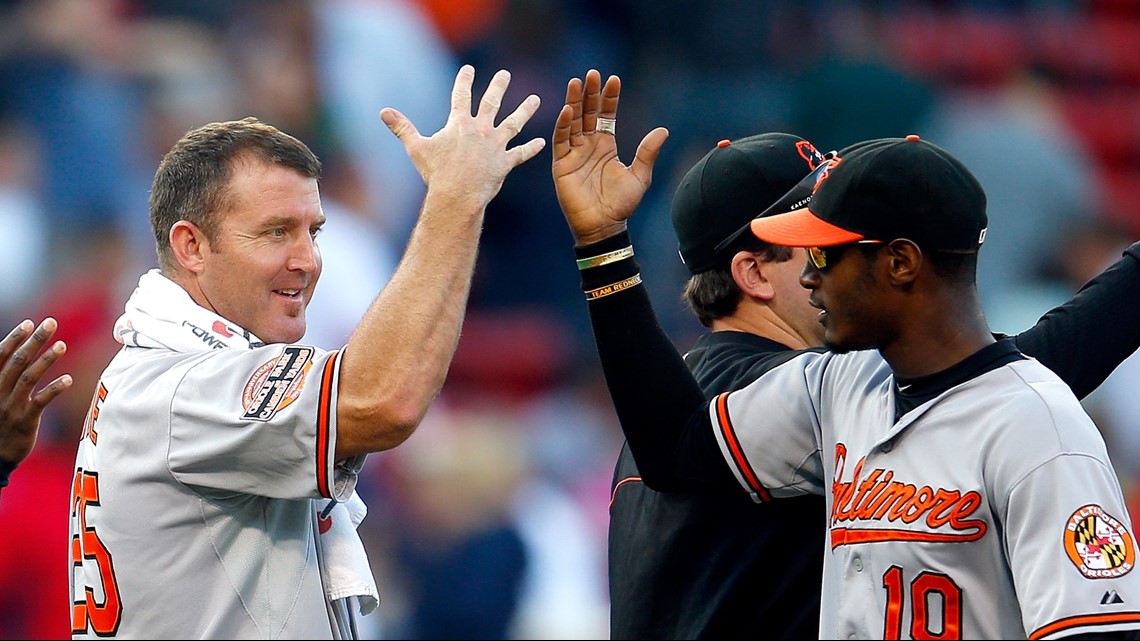
Back in the lineup on Sept. 26, Thome hit a solo homer off Carlos Villanueva in a 12-2 win over the Toronto Blue Jays. It would turn out to be the last home run of his career.
The Orioles clinched a postseason berth four days later, and went on to defeat the Texas Rangers 5-1 in the first ever American League Wild Card Game before falling to the New York Yankees in a hard-fought ALDS. Thome went 1-for-12 in what was his last shot at a world championship.

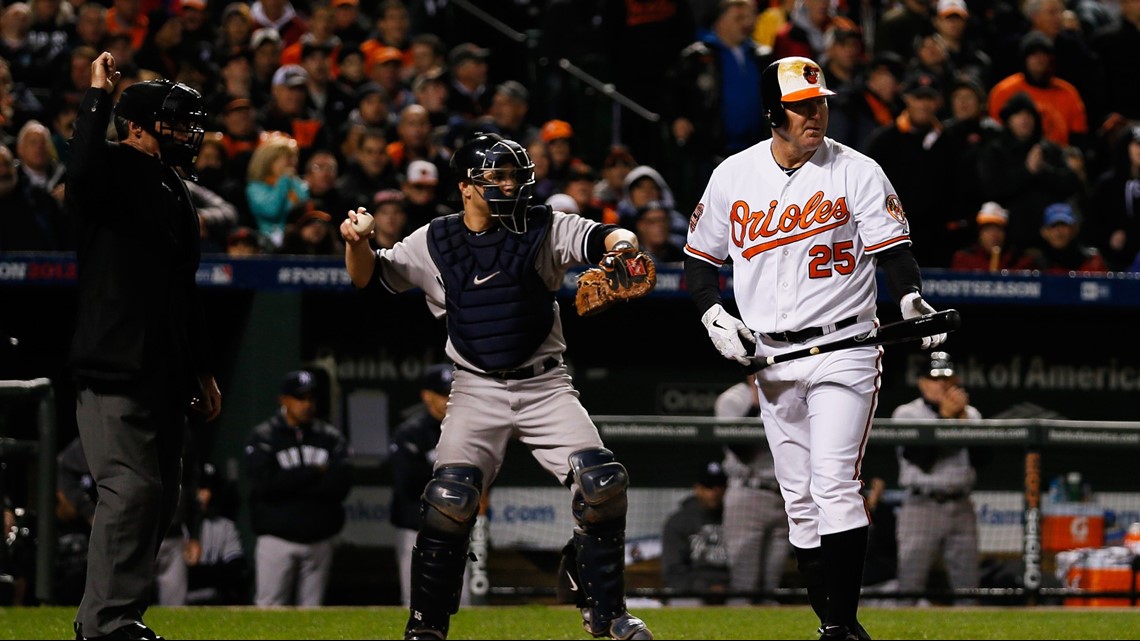
Though he did not officially announce his retirement, Jim Thome would never play in the big leagues again. In 2,543 games over a 22-year career, Thome slashed .276/.402/.554 with 612 home runs, 1,699 RBIs, 1,747 walks, 1,583 runs scored, and 72.9 WAR. He also made the postseason 10 times, where he hit 17 more homers. Perhaps most important of all, he was loved and respected by each and every team and fan base that had come to know him.
2013
Starting the next life
Despite still technically being active, Thome was hired by the White Sox in July as a special assistant to the general manager. He still holds that position to this day, often working with players on their hitting. He has stated his aspirations to one day be a manager.
Thome maintained strong ties with the Indians organization as well, and received a raucous ovation from the Progressive Field crowd during the AL Wild Card Game on Oct. 3.

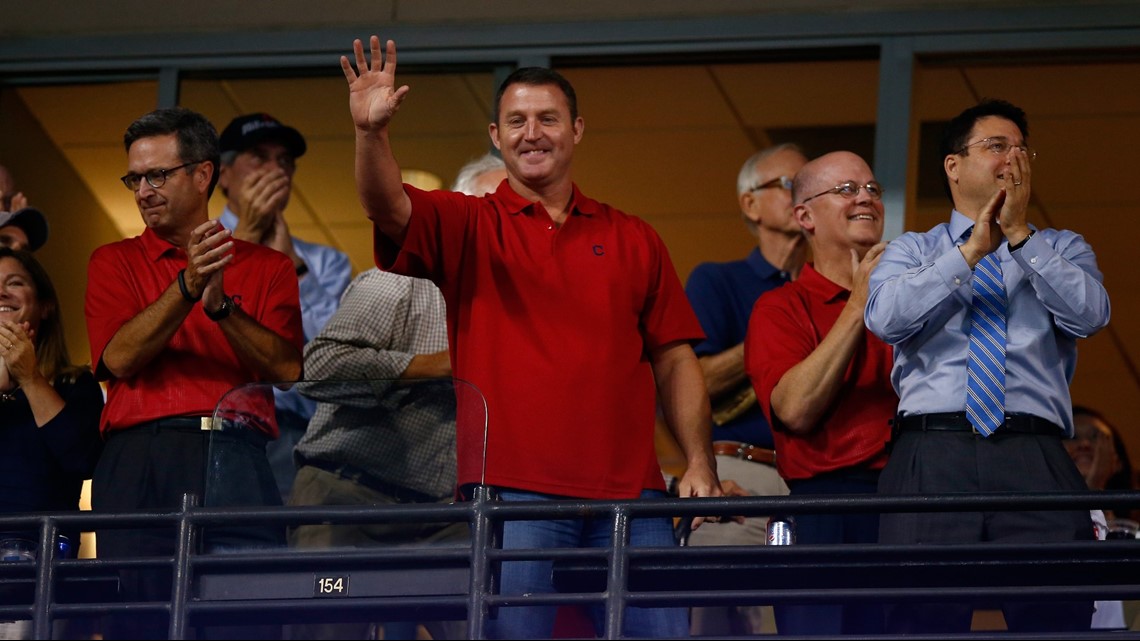
2014
A Cleveland legend
On Aug. 2, 2014, Thome and his family returned to Cleveland, where a bronze statue depicting his famous "bat point" was unveiled. Some fans questioned the gesture, partly due to Thome's 2003 departure and also because other Indians heroes like Larry Doby and Lou Boudreau had not yet received such an honor. However, as a future Hall of Famer and a fixture of the late '90s bunch, most saw the team's all-time home run king as a more-than-worthy candidate.

An emotional Thome thanked the team and the fans for their support, and described the monument as symbolic of the '90s era. He also made an announcement: He was signing an honorary, one-day contract, allowing him to officially retire as a member of the Cleveland Indians.
There was one more surprise: Multiple players had worn the number 25 since Thome left, including veteran Jason Giambi. But on this day, Giambi decided to voluntarily give it up, telling Jim he was his honor to do so. While the Tribe has not yet fully retired No. 25, they have stated no player will ever wear it again.


2016
The 'first' Hall of Fame
Before he could get into Cooperstown, Thome was inducted as a member of the Cleveland Indians Hall of Fame on July 30, 2016. He gave a special shout-out to the Cavs (who had won the NBA championship just weeks before) in his acceptance speech.
Less than two weeks later, Thome was also inducted into the Philadelphia Phillies Wall of Fame. Though he played only parts of four seasons in the city, he remained a popular figure, and was selected for the honor by the Philly fans.

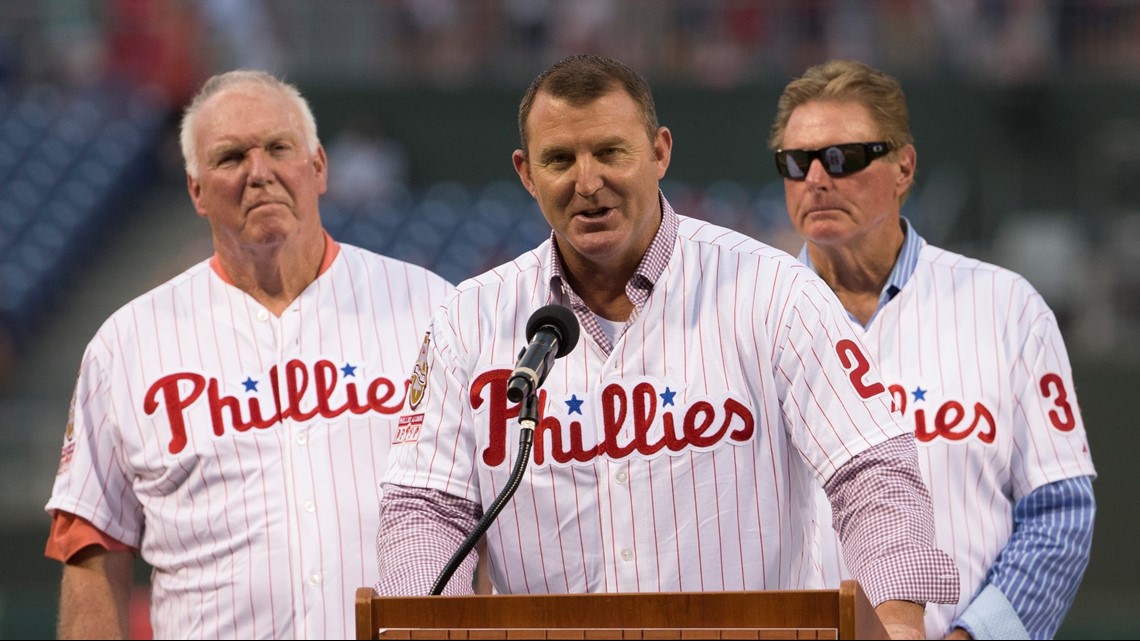
Later, on Nov. 2, Thome was back in Cleveland to throw out the ceremonial first pitch prior to Game 7 of the World Series. It was a special moment, but just like 1997, the Tribe sadly lost in extra innings.
2017
Smile for the camera
Like he had done to end 2016, Thome came to Progressive Field in 2017 to throw out the first pitch before the Indians' home opener. This time, he was flanked by fellow Cleveland sports heroes Jim Brown and Austin Carr.

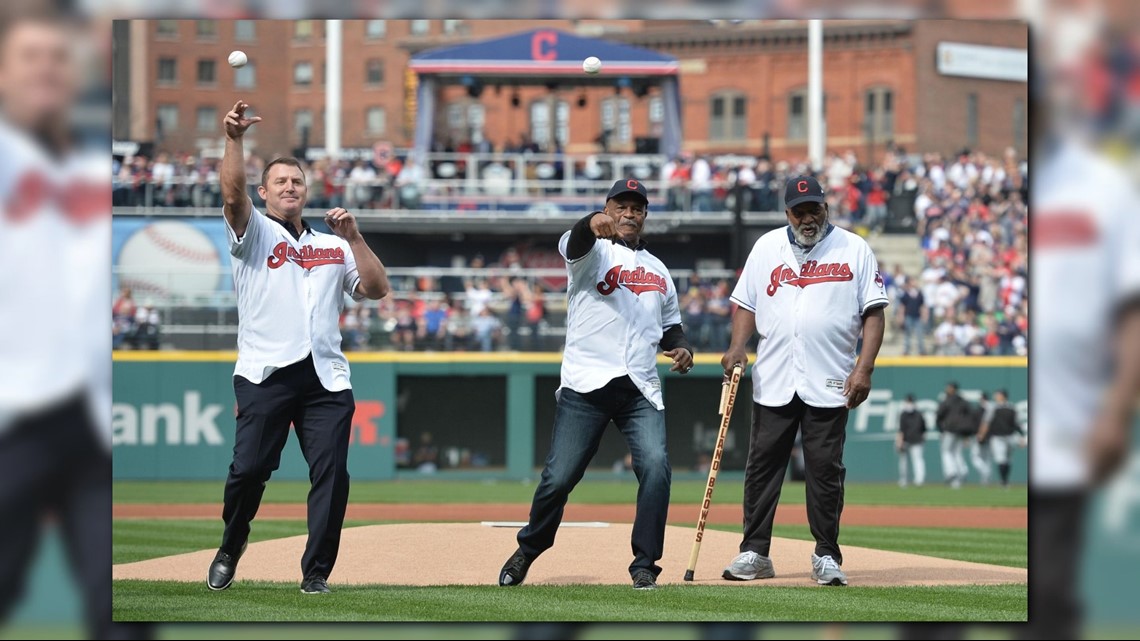
Jim also added "TV star" to his resume, becoming an analyst for MLB Network.
2018
'The call'
Jan. 24, 2018.
Jim Thome, alongside his wife Andrea and kids Lila and Landon (who was wearing an Indians cap), received the call most players can only dream about: He had been elected to the National Baseball Hall of Fame.
His name appeared on 89.8 percent of all ballots in his first year of eligibility, as he joined a class that included Chipper Jones, Vladimir Guerrero, Trevor Hoffman, Alan Trammell, and Jack Morris.
Chuck Thome, watching from Gebby's restaurant in Peoria, was in tears as the announcement was made.
Thome will be inducted on July 29, with his plaque depicting a Cleveland Indians logo.




